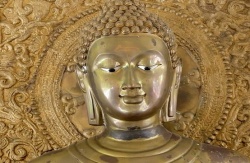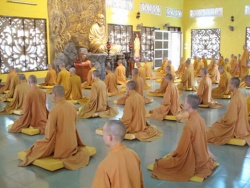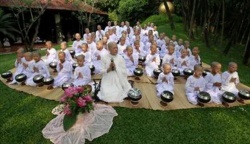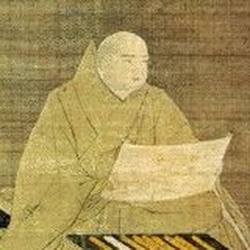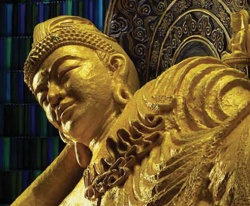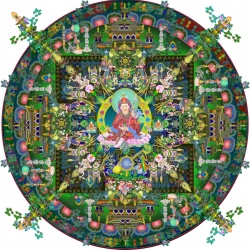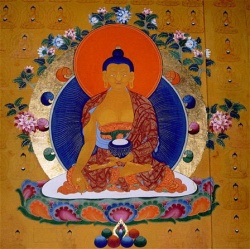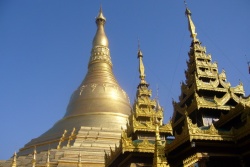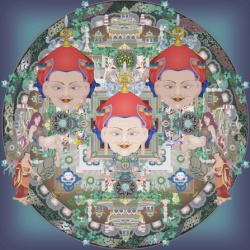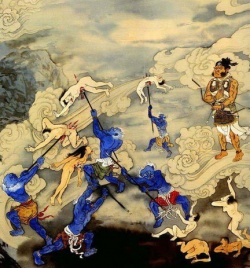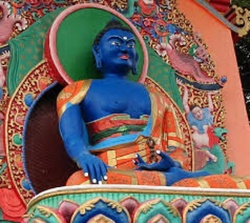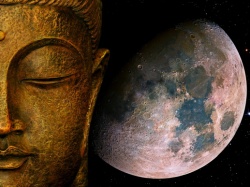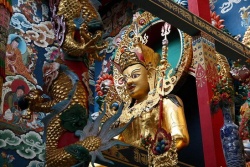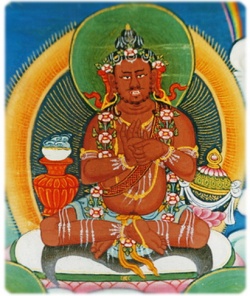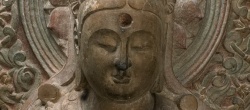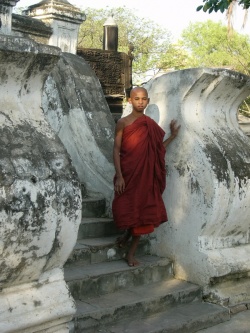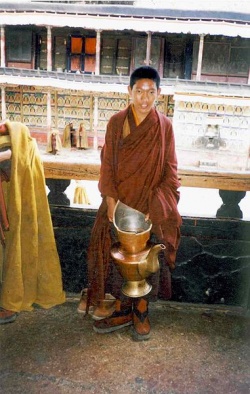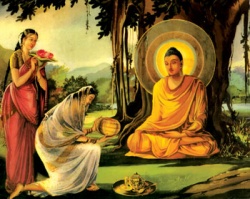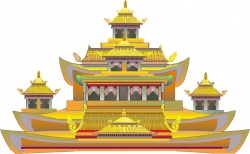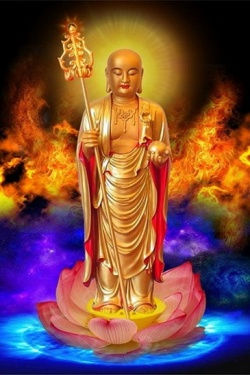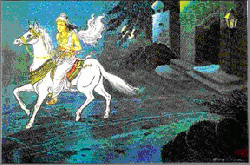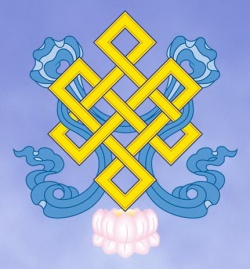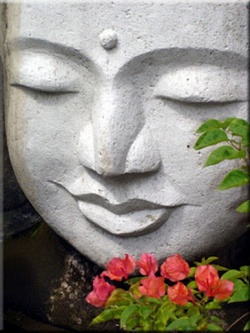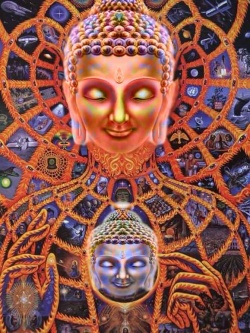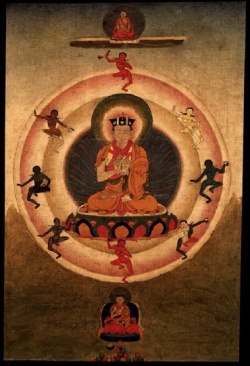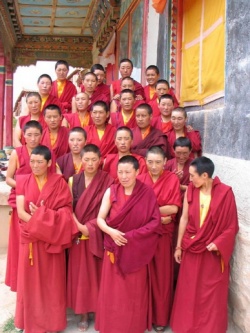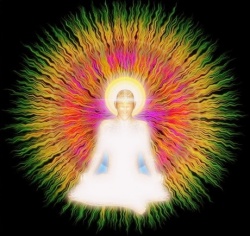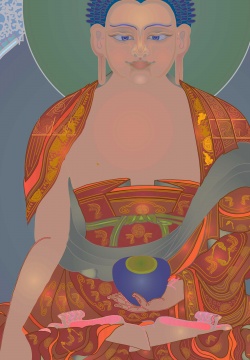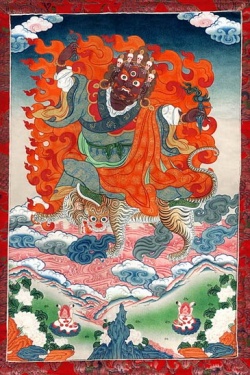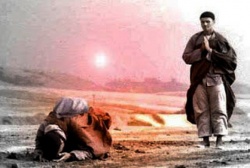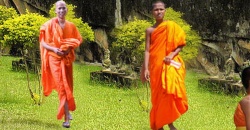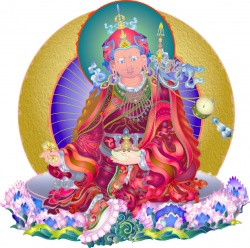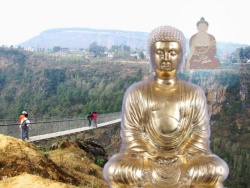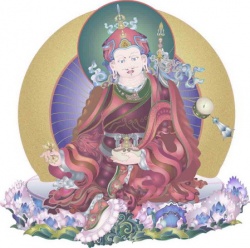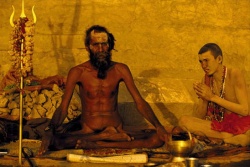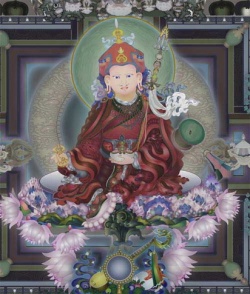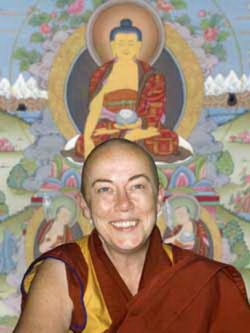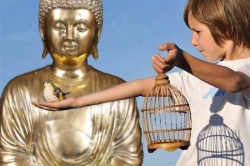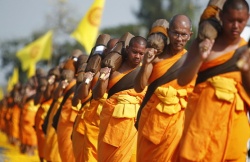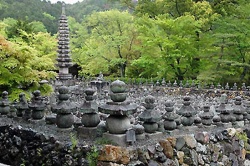What is Dependant Origination
THE SUBTLEST DHAMMA (PATICCASAMUPPADA SUTTA - MAHASI SAYADAW)
The doctrine of Paticcasamuppada or Dependent Origination is very important in Buddhism. The bodhisatta began with dependent origination when he reflected deeply on the nature of existence and attained Enlightenment. He first pondered old age and death, as did every other bodhisatta when he was about to become the Buddha in his last existence. For it was only after seeing the old, the sick and the dead that the bodhisatta saw the ascetic (samana) and renounced the world in search of the ageless and the deathless Dhamma. He had seen the evils of life in old age, sickness and death.
Every living being wants to avoid these evils of life but there is no end to these evils which follow him in one existence after another. In view of this endless process of life all living beings appear to be in bondage and subject to suffering. Life is in fact an infinite process of births and deaths. The fate of fowls and ducks is terrible indeed. Some are eaten up while still in the eggs. If they emerge from the eggs they do not live long but are killed when they grow up a little. They are born only to be killed for human consumption. If the fate of a living being is thus to be repeatedly killed it is gloomy and frightful indeed.
But the fowls and ducks appear to be well content with their lot in life. They apparently enjoy life, quacking, crowing, eating and fighting with one another. They may think that they have a lot of time to live although in fact they have little time to be happy, their life being a matter of days or months, with each of them coming into existence and then dying after a short time.
The span of human life, too, is not very long. For the man in his fifties or sixties the past seems in retrospect as recent as yesterday. Sixty or seventy years on earth is a day in the life of a deva which is, however, very short in the eyes of a Brahma who may live as long as the duration of the worlds (kappa). But even the Brahma who outlives hundreds of worlds is insignificant and his life is short in the context of samsaric eternity. Devas and Brahmas, too, have to age and die eventually. Although they are not subject to sickness and marked dotage, age tells on them invisibly in due course of time. So every living being has to face old age and death and nobody can escape from these evils of life.
REFLECTION OF THE BODHISATTA
Reflecting on the origin of old age, the bodhisatta traced back the chain of dependent origination from the end to the beginning. Old age and death have their origin in rebirth which in turn is due to kamma bhava (condition or kamma for renewed existence.) kammabhava stems from grasping or attachment (upadana) which is caused by craving (tanha) Craving arises from feeling (vedana) which is produced by sense-bases (ayatana) such as eye, visual form, etc. Sense-bases are the product of nama-rupa (consciousness and corporeality) which results from viññana (consciousness) which is again caused by namarupa.
The full Pali texts about Paticcasamuppada attribute viññana to sankhara (kammaformations) and sankhara to avijja (ignorance). But the bodhisatta's reflection is confined to the interdependence of namarupa and viññana in the present life. In other words, he reflected on the correlation between viññana and namarupa, leaving out of account the former's relation to past existence. We may assume therefore that for the meditators reflection on the present life will suffice to ensure the successful practice of vipassana.
ANULOMA REASONING
The bodhisatta reasoned about the correlation between viññana and namarupa thus: "This viññana has no cause other than nämarüpa. From namarupa there results viññanas; from viññana there arises namarupa. Hence from the correlation between viññäna and namarupa there arise birth, old age and death; there may be successive births or successive deaths." Moreover viññana causes namarupa: namarupa causes sense-bases (ayatana). From sensebases there arises contact; contact leads to feeling, feeling gives rise to craving, craving to grasping, and grasping results in rebirth which in turn leads to old age, death, anxiety, grief and other kinds of mental and physical suffering.
Then the bodhisatta reflected on dependent origination negatively. If there were no viññana there could be no namarupa; if no namarupa, then no ayatana and so on. The negation of the first link in the cha in of causation leads to the extinction of suffering that has be set us ceaselessly in the infinite series of samsaric existences. After this reflection on dependent origination in its positive and negative aspects, the bodhisatta contemplated the nature of the aggregates of grasping. Then he attained the successive insights and fruitions (maggaphala) on the Ariyan holy path and finally became the all-Enlightened Buddha.
Every bodhisatta attained supreme Enlightenment after such contemplation. They did not learn what and how to contemplate from others but owing to cumulative potential (parami) that they had acquired through innumerable lifetimes, they contemplated as mentioned before and attained Enlightenment.
BEYOND REASONING AND SPECULATION
Then when it was time to preach the Buddha thought thus: This dhamma which I know is very profound. It is hard to understand; it is so sublime and so conducive to inner peace. It is not accessible to intellect and logic (atakkavacaro). It is subtle and it is to be realized only by the wise. All over the world philosophers have racked their brains about freedom from old age, sickness and death. But freedom from these evils means nibbāna and nibbāna is beyond the reach of reason and intellect. It is to be realized only through the practice of the middle way and vipassana.
Most philosophers rely on intellect and logic and there are various doctrines which they have conceived for the welfare of all living beings. But these doctrines are based on speculations that do not help anyone to attain vipassana insight, let alone the supreme goal of nibbāna. Even the lowest stage of vipassana insight, viz., insight into the distinction between nama and rupa does not admit of intellectual approach. The insight dawns on the meditator only when, with the development of concentration, and in accordance with Satipatthana method he watches the namarupa process and distinguished between consciousness and corporeality, e.g. the desire to bend the hand and bent hand, the ear and the sound on the one hand and the consciousness of hearing on the other and so forth. Such knowledge is not vague and speculative; it is vivid and empirical. It is said on the authority of scriptures that namarupas are in a constant flux and that we should watch their arising and passing away. But for the beginner this is easier said then done.
The beginner has to exert strenuous effort to overcome hindrances (nivarana). Even freedom from nivarana helps him only to distinguish between nama and rupa. It does not ensure insight into their arising and passing away. This insight is attained only after concentration has been developed and perception has become keen with the practice of mindfulness. Constant mindfulness of arising and vanishing leads to insight into anicca, dukkha and anatta of all phenomena. But as merely the beginning of lower vipassana, this insight is a far cry from the path and its fruition. Hence the description of the dhamma as something beyond logic and speculation.
DHAMMA IS ONLY FOR THE WISE
The dhamma is subtle (nipuno); it is to be realized only by the wise (panditavedaniyo). Here the wise means only those who have wisdom (pañña) relating to vipassana and the path and its goal. The dhamma has nothing to do with the secular knowledge per se possessed by world philosophers, religious founders, writers or great scientists who can split atoms. But it can be realized by any one irrespective of sex, age or education, anyone who contemplates namarupa at the moment of their arising, passes through vipassana insights progressively and attains the Ariyan path and its goal.
Taking stock of the nature of all living beings, the Buddha found that most of them were mired in sensual pleasure. There were of course a few exceptions like the five companions of Siddhattha in the forest retreat or the two brahmins who were later to become the two chief disciples of the Buddha. But the majority of mankind regard the enjoyment of pleasure as the summum bonum of life. They are like children who delight in playing with their toys the whole day. The child's toys and games make no sense to adults but grown-up people too derive pleasure from the toys of the sensual world, that is, from the company of their children and grand children. Such sensual pleasure has no appeal for Buddhas and Arahats. It is highly esteemed by ordinary men and devas because they have no sense of higher values such as jhana, vipassana and nibbāna.
A person who is thus fond of sensual pleasure ma y be likened to a peasant living in out-ofthe- way rural areas. To the urbanites those places are wholly devoid of the amenities of life, what with poor food, poor clothes, dirty dwellings, muddy foot-paths, and so forth. But the villagers are happy and they never think of leaving their native place. Likewise, common people and devas delight in their sensual objects. Whatever the teaching of Buddha and the Arahats, they love pleasure and spend all their time indulging in it. They feel ill at ease in the absence of sensual objects. They are so much pleased with their families, attendants and possessions that they cannot think of anything higher than sensual pleasure. Because of their deep-rooted love of pleasure, it is hard for them to understand or appreciate the subtle, profound Paticcasamuppada and nibbāna.
DIFFICULTY OF UNDERSTANDING
The Buddha-dhamma makes little appeal to the masses since it is diametrically opposed to their sensual desire. People do not like even an ordinary sermon, let alone a discourse on nibbāna, if it has no sensual touch. They do not seem interested in our teaching and no wonder, since it is devoid of melodious recitation, sentimental stories and hilarious jokes and other attractions. It is acceptable only to those who have practised vipassana or who seek the dhamma on which they can rely for methods of meditation and extinction of defilements. But it is a mistake to deprecate, as some do, the sermons containing stories, jokes, etc as sutta sermons. Suttas differ basically from popular sermons in that they are profound, as witness Anattalakkhana sutta, Satipatthana sutta and so forth.
The doctrine of Dependent Origination too belongs to Sutta Pitaka. It is to be labelled Abhidhamma only because it is preached in the fashion of Abhidhamma Pitaka. Since our teaching is unadulterated dhamma, some people confuse it with Abhidhamma and cannot follow it, much less grasp the Path and nibbāna which it emphasizes. Paticcasamupada is hard to understand because it concerns the correlations between causes and effects. There is no ego entity that exists independently of the law of causation. It was hard to accept this fact before the Buddha proclaimed the dhamma. The commentaries also points out the abstruse character of the doctrine. According to them there are four dhammas which defy understanding, viz., the four noble truths, the nature of a living being, the nature of rebirth and dependent origination.
It is hard to understand and accept the truth of suffering, the truth about its cause, the truth about its cessation and the truth about the way to its extinction. It is hard to appreciate these truths, still harder to teach them to other people. Secondly, it is hard to understand that a living being is a nama-rupa process without any separate self, that the namarupa complex is subject to the law of kamma that determines a man's future life according to his good or bad deeds. In the third place, it is hard to see how rebirth takes place as a result of defilement and kamma without the transfer of nama-rupa from a previous life.
Lastly it is equally hard to understand Paticcasamuppada. It involves the above three abstruse dhammas. Its negative aspect concerns the first two noble truths as well as the nature of a living being and rebirth while its positive aspect involves the other two truths. Hence it is most difficult to grasp or teach this doctrine. It may be easy to explain it to one who has attained the path and nibbāna or one who has studied the pitaka but it will mean little to one who has neither the illumination nor scriptural knowledge. The writer of the commentary on the doctrine was qualified to explain it because he might have attained the lower stages of the path or he might have a thorough knowledge of the Pitaka.
He refers to its difficulty probably in order that its exposition might be seriously studied by posterity. He likens the difficulty to the plight of a man who has jumped into the sea and cannot get to the bottom. He admits that he has written the exegesis on the basis of the Pitaka and the old commentaries handed down by oral tradition. The same may be said of our teaching. Since it is hard to explain the doctrine, the meditator sho uld pay special attention to it. If he follows the teaching superficially, he will understand nothing and without a fair knowledge of the doctrine, he is bound to suffer in the wilderness of samsaric existence.
The substance of the Paticcasamuppada teaching is as follows.
From ignorance there arises sankhara (effort or kamma-formation.) From kamma-formation there arises consciousness of the new existence. Consciousness gives rise to psycho-physical phenomena or nama-rupa. Nama-rupa leads to ayatana (six bases). From ayatana arises the phassa (impression). Phassa causes feeling; feeling leads to craving. From craving there results clinging (upadana). Because of clinging there is the process of becoming (kamma-bhava), from the process of becoming there arises rebirth (jati) and rebirth leads to old age, death, sorrow, grief, and lamentation. Thus arises the whole mass of suffering.
Ignorance to Formations
WHAT IS AVIJJA (IGNORANCE)?
According to the Buddha, avijja is ignorance of the four Noble Truths, viz, the truths about suffering, its cause, its cessation and the way to its cessation. In a positive sense avijja implies misconception or illusion. It makes us mistake what is false and illusory for truth and reality. It leads us astray and so it is labelled micchapatipatti-avijja. Avijja therefore differs from ordinary ignorance. Ignorance of the name of a man or a village does not necessarily mean misinformation whereas the avijja of Paticcasmuppada means something more than ignorance. It is misleading like the ignorance of a man who has lost all sense of direction and who therefore thinks that the east is west or that the north is south.
The man who does not know the truth of suffering has an optimistic view of life that is full of dukkha (pain and evil). It is mistake to seek the truth of dukkha in the book for it is to be found in one's own body. Seeing, hearing, in short, all nama-rupa arising from the six senses are dukkha. For this phenomenal existence is impermanent, undesirable and unpleasant. It may end at any time and so all is pain and suffering. But this dukkha is not realized by living beings who look upon their existence as blissful and good. So they seek pleasant sense-objects, good sights, good sounds, good food, etc. Their effort to secure what they believe to be the good things of life is due to their illusion (avijja) about their existence.
Avijja is here like the green eye-glass that makes a horse eat the dry grass which it mistakes for green grass. Living beings are mired in sensual pleasure because they see every thing through rose-coloured glasses. They harbour illusions about the nature of sense-objects and namarupa. A blind man may be easily deceived by another man who offers him a worthless longyi, saying that it is an expensive, high quality longyi. The blind man will believe him and he will like the longyi very much. He will be disillusioned only when he recovers his sight and then he will throw it away at once. Like-wise, as a victim of avijja, a man enjoys life, being blind to its anicca, dukkha and anatta. He becomes disenchanted when introspection of nama-rupa makes him aware of the unwholesome nature of his existence.
Introspection of nama-rupa or vipassana contemplation has nothing to do with bookish knowledge. It means thorough watching and ceaseless contemplation of all psycho-physical phenomena that comprise both the sense-objects and the corresponding consciousness. The practice leads to full awareness of the ir nature. As concentration develops, the meditator realizes their arising and instant vanishing, thereby gaining an insight into their anicca, dukkha and anatta. Avijja makes us blind to reality because we are unmindful. Unmindfulness gives rise to the illusion of man, woman, hand, leg, etc., in the conventional sense of the terms. We do not know that seeing, for instance, is merely the nama-rupa or psycho-physical process, that the phenomenon arises and vanishes, that it is impermanent, unsatisfactory and unsubstantial.
Some people who never contemplate die without knowing anything about nama-rupa. The real nature of nama-rupa process is realized by the mindful person. But the insight does not occur in the beginning when concentration is not yet developed. Illusion or the natural way of consciousness precedes contemplation and so the beginner does not gain a clear insight into the nature of namarupa. It is only through steadfast practice that concentration and perception develop and lead to insight-knowledge. If, for example, while practising mindfulness, the meditator feels itchy, he is barely aware of being itchy. He does not think of the hand, the leg, or any other part of the body that is itchy nor does the idea of self as the subject of itchiness, "I feel itchy" occurs to him. There arises only the continuous sensation of itchiness. The sensattion does not remain permanent but passes away as he notes it. The watching consciousness promptly notes every psycho-physical phenomenon, leaving no room for the illusion of hand, leg and so on. Illusion dominates the unmindful person and makes him blind to the unsatisfactory nature (dukkha) of all sense-objects. It replaces dukkha with sukha. Indeed avijja means both ignorance of what is real and misconception that distorts reality.
Because he does not know the truth of dukkha, man seeks pleasant sense-objects. Thus ignorance leads to effort and activity (sankhara). According to the scriptures, because of avijja there arises sankhara but there are two links, viz, tanha and upadana between them. Ignorance gives rise to craving (tanha) which later on develops into attachment (upadana). Craving and attachment stem from the desire for pleasure and are explicitly mentioned in the middle part of the doctrine of Paticcasamuppada. When the past is fully described, reference is made to avijja, tanha, upadana, kamma and sankhara.
IGNORANCE OF THE ORIGIN OF DUKKHA
People do not know that craving is the origin (samudaya) of suffering. On the contrary they believe that it is attachment that makes them happy, that without attachment life would be dreary. So they ceaselessly seek pleasant sense-objects, food, clothing, companion and so forth. In the absence of these objects of attachment they usually feel ill at ease and find life monotonous. For common people life without attachment would be indeed wholly devoid of pleasure. It is tanha that hides the unpleasantness of life and makes it pleasant. But for the Arahat who has done away with tanha, it is impossible to enjoy life. He is always bent on nibbāna, the cessation of conditioned suffering.
Tanha cannot exert much pressure even on the meditators (meditators) when they become absorbed in the practise of vipassana. So some meditators do not enjoy life as much as they did before. On their return from meditation retreat they get bored at home and feel ill at ease in the company of their families. To other people the meditator may appear to be conceited but in fact his behaviour is a sign of loss of interest in the workaday world. But if he cannot as yet overcome the sensual desire, his boredom is temporary and he usually gets readjusted to his home life in due course. His family need not worry over his mood or behaviour for it is not easy for a man to become thoroughly sick of his home life.
So the meditator should examine himself and see how much he is really disenchanted with life. If his desire for pleasure lingers, he must consider himself still in the grip of tanha. Without tanha we would feel discomfited. In conjunction with avijja, tanha makes us blind to dukkha and creates the illusion of sukha. So we frantically seek sources of pleasure. Consider, for example, men's fondness for movies and dramatic performances. These entertainments cost time and money but tanha makes them irresistible although to the person who has no craving for them they are sources of suffering.
A more obvious example is smoking. The smoker delights in inhaling the tobacco smoke but to the non-smoker it is a kind of self- inflicted suffering. The non-smoker is free from all the troubles that beset the smoker. He leads a relatively care- free and happy life because he has no craving for tobacco. Tanha as the source of dukkha is also evident in the habit of betel-chewing. Many people enjoy it although in fact it is a troublesome habit. Like the smoker and the betel-chewer people seek to gratify their craving and this tanha, inspired effort is the mainspring of rebirth that leads to old age, sickness and death. Suffering and desire as its cause are evident in everyday life but it is hard to see these truths. For they are profound and one can realize them not through reflection but only through the practice of vipassana.
IGNORANCE OF THE THIRD AND FOURTH NOBLE TRUTHS
Avijja also means ignorance of the cessation of dukkha and the way to it. These two truths are also profound and hard to understand. For the truth about cessation of dukkha concerns nibbāna which is to be realized only on the Ariyan holy path and the truth about the way is certainly known only to the meditator who has attained the path. No wonder that many people are ignorant of these truths. Ignorance of the end of suffering is widespread and so world religions describe the supreme goal in many ways. Some say that suffering will come to an end automatically in due course of time. Some regard sensual pleasure as the highest good and reject the idea of a future life. This variety of beliefs is due to ignorance of the real nibbāna.
Even among Buddhists some hold that nibbāna is an abode or a sort of paradise and there are many arguments about it. All these show how hard it is to understand nibbāna. In reality nibbāna is the total extinction of the nama-rupa process that occurs ceaselessly on the basis of causal relationship. Thus according to the doctrine of Paticcasamuppada, avijja, sankhara, etc give rise to nama-rupa, etc and this causal process involves old age, death and other evils of life. If avijja, etc become extinct on the Ariyan path, so do their effects and all kinds of dukkha and this complete end of dukkha is nibbāna.
For example, a lamp that is refueled will keep on burning but if it is not refueled there will be a complete extinction of flame. Likewise for the meditator on the Ariyan path who has attained nibbāna, all the causes such as avijja, etc., have become extinct and so do all the effects such as rebirth, etc. This means total extinction of suffering, that is, nibbāna which the meditator must understand and appreciate before he actually realizes it. This concept of nibbāna does not appeal to those who have a strong craving for life. To them the cessation of nama-rupa process would mean nothing more than eternal death. Nevertheless, intellectual acceptance of nibbāna is necessary because on it depends the meditator's whole-hearted and persistent effort to attain the supreme goal.
Knowledge of the fourth truth, viz, truth about the way to the end of dukkha is also of vital importance. Only the Buddhas can proclaim the right path; it is impossible for anyone else, be he a deva, a Brahmä or a human being, to do so. But there are various speculations and teachings about the path. Some advocate ordinary morality such as love, altruism, patience, alms giving, etc., while others stress the practice of mundane jhana. All these practices are commendable. According to the Buddhist teaching, they lead to relative welfare in the deva-Brahma worlds but do not ensure freedom from samsaric dukkha such as old age, etc., so they do not form the right path to Nibban although they are helpful in the effort to attain it. Some resort to self- mortification such as fasting, living in a state of nature and so forth. Some worship devas or animals.
Some live like animals. From the Buddhist point of view all these represent what is termed silabbataparamasa which means any practice that has nothing to do with the Eightfold Path. The Eightfold Noble Path comprises right view, right intention, right speech, right action, right livelihood, right effort, right mindfulness and right contemplation. The path is of three kinds, viz., the basic path, the preliminary path and the Ariyan path. Of these the most vital is the Ariyan path but this path should not be the primary objective of the meditator nor does it require him to spend much time and energy on it. For as the vipassana practice on the preliminary path develops, the insight on the Ariyan leve l occurs for a thought-moment. For example, it requires much time and effort to produce fire by friction but ignition is a matter of a moment's duration. Similarly, the insight on the Ariyan path is instantaneous but it presupposes much practice of vipassana on the preliminary path.
AVIJJA LEADS TO SANKHARA
To them sensual pleasure is the source of happiness, nibbāna as the extinction of nama-rupa is undesirable and the way to it is arduous and painful. So they seek to gratify their desire through three kinds of action (kamma) viz., bodily action, verbal action and mental action. Some of these actions may be ethically good and some may be ethically bad. Some people will practice dana, etc for their welfare hereafter, while some will resort to deceit or robbery to become rich. A Pali synonym for kamma (action) is sankhara. Sankhara is also of three kinds, viz., sankhara by thought, sankhara by speech and sankhara by body. Sankhara presupposes cetana (volition).
The function of cetana is to conceive, to urge or to incite and as such it is the mainspring of all actions. It is involved in killing, alms-giving, etc. The meditator knows its nature empirically through contemplation. In another sense there are three kinds of sankharas, viz, puññabhi (wholesome) sankhara, with its good kammic result, apuññabhi (unwholesome) sankhara with its bad kammic result and aneñjabhi-sankhara that leads to wholesome arupajhana which literally means immobile jhana. Rupajhana and all the good actions having the kammic results in the sensual world are to be classified as puññabhisankhara. Puñña literally means something that cleanses or purifies. Just as a man washes the dirt off his body with soap, so also we have to rid ourselves of kammic impurities through dana, sila and bhāvanā.
These good deeds are conducive to welfare and prosperity in the present life and hereafter. Another meaning of puñña is the tendenc y to fulfil the desire of the doer of the good deed. Good deeds help to fulfil various human desires, e.g., the desire for health, longevity, wealth and so forth. If a good deed is motivated by the hope for nibbāna, it leads to a life that makes it possible to attain his goal or it may ensure his happiness and welfare till the end of his last existence. Abhisankhara is the effort to do something for one's own welfare. It tends to have good or evill kammic results.
So puññabhi sankhara is good deed with good kammic result. There are eight type of good deed in sensual sphere (kamavacarakusala) and five types in fine material sphere (rupavacara). All these may be summed up as of three kinds, viz., dana, sila and bhāvanā. Giving dana gladly means wholesome consciousness which is kammically very fruitful. So the donor should rejoice before, during and after the act of alms-giving. In the scriptures this kind of dana is credited with great karmic productivity. The attitude of the donor may also be one of indifference (upekkha) but if the mind is clear, his act of dana too has high kammic potential. Any act of alms-giving that is based on the belief in kamma is rational and it may bear fruit in the form of rebirth with no predisposition to greed, ill-will and ignorance. An act of dana that has nothing to do with a sense of its moral value or the belief in kammic result is good but unintelligent and it will lead to rebirth with no great intelligence.
It may bear such kammic fruit in everyday life but it does not make the donor intelligent enough to attain the path in his next life. Again one may do a good deed spontaneously without being urged by others (asankharikakusala); some do good deeds at the instigation of others (sasankharika-kusala). Of these two kinds of good deeds the former is kammically more fruitful than the later. When we consider the four kinds of deeds the former is kammically more fruitful than the later. When we consider the four kinds of good deeds mentioned earlier in terms of these last two attributes, we have a total of eight types of wholesome consciousness in the sensual sphere.
Whenever we do a good deed, we are prompted to do so by one of these kusala dhammas; when we practise concentration and meditation, we have to begin with these eight types of wholesome dhammas. It is bhāvanā that can lead to jhana, the meditator attains rupavacara jhana when his samadhi is well developed. Jhana means total concentration of mind on an object of mental training. Samatha- Jhana is concentration for bare tranquility. Jhana samadhi is like flame burning in still air. According to the Suttas, the rupavacara jhana has four levels; in Abhidhamma it has five levels.
Formations to Consciousness
SANKHARA CAUSES VIÑÑANA
Because of avijja there is sankhara which in turn causes viññana. As the result of the good or bad kamma in the previous life there arises the stream of consciousness beginning with rebirth consciousness in the new life. Evil deeds may, for example, leads to the four lower worlds. After that there arises the stream of viññana called bhavanga-citta which functions ceaselessly when the six kinds of vithi consciousness do not occur at the moment of seeing, hearing, smelling, eating, touching and thinking. In other words, bhavanga is the kind of subconsciousness that we have when we are asleep. We die with this subconsciousness and it is then called cutti-citta. So the rebirthconsciousness, the subconsciousness and the cuti or death consciousness represent the mind which results from the kamma of previous life.
The five kinds of consciousness associated with the five unpleasant sense-objects such as unpleasant eye-consciousness, ear-consciousness, etc., are due to unwholesome kamma as are (1) the consciousness that is focussed on these five sense-objects and (2) the inquiring (santirana) consciousness. There are altogether seven types of consciousness that stem from bad kamma (apuññabhisankhara). As for aneñjabhi-sankhara, because of the four arupakusala-dhammas there arises the resulting arupa-consciousness in the four immaterial worlds in the form of rebirthconsciousness in the beginning, the bhavanga citta in the middle and the cuticitta as the end of existence.
Similarly because of the five rupakusala-dhammas there arise five rupa vipakacittas in rupabrahma worlds. Then there are eight mahavipakacittas corresponding to eight good kammas in the sensual sphere. They form the rebirth, bhavanga and cuti cittas in the human words and six devaworlds. They also register pleasant sense-objects (tadarammana) after seven impulse-moments (javana) that occur on seeing, hearing, etc. Also due to good kamma of the sensual sphere are the five kinds of consciousness associated with five pleasant sense-objects, the registering consciousness, the joyful, inquiring consciousness and the nonchalant, inquiring consciousness. Hence the resulting (vipaka) consciousness is of thirty two kinds, viz., four arupavipaka, five rupavipaka, seven akusala vipaka and sixteen kusala vipaka in sensual sphere. All these thirty-two vipaka are resultants of sankhara.
HOW SANKHARA LEADS TO NEW VIÑÑANA
It is very important but hard to understand how sankhara gives rise to rebirth-consciousness. Ledi Sayadaw points out that this part of the teaching on Paticcasamuppada leaves much room for misunderstanding. It is necessary to understand the extinction of the last consciousness (cuti citta) together with all nama-rupa as well as the immediate arising of the rebirth-consciousness (Patisandhi citta) together with the new nama-rupa as a result of good or bad kammas in the case of living beings who are not yet free from defilements. Lack of this understanding usually leads to the belief in transmigration of souls (sassataditthi) or the belief in annihilation after death (ucchedaditthi) which is held by modern materialists.
The belief in annihilation is due to ignorance of the rela tion between cause and effect after death. It is easy to see how avijja leads to sankhara and how the sense-bases (ayatana), contact, sensation, craving, etc form links in the chain of causation for these are evident in the facts of life. But the emergence of new existence following death is not apparent and hence the belief that there is nothing after death. Learned people who think on the basis of faith usually accept the teaching that sankhara gives rise to rebirth consciousness. But it does not lend itself to purely rational and empirical approach and today it is being challenged by the materialistic view of life.
The way rebirth takes place is crystal clear to the meditator who has practised vipassana. He finds that the units of consciousness arise and pass always ceaselessly, that they appear and disappear one after another rapidly. This is what he discovers by experience, not what he learns from his teachers. Of course he does not know so much in the beginning. He discovers the fact only when he attains sammasana and udayabbaya insights. The general idea of death and rebirth mental units dawns on him with the development of paccaya-pariggaha insights but it is sammasana and udayabbaya insights that leave no doubt about rebirth. On the basis of his insight he realizes that death means the disappearance of the last unit of consciousness and that rebirth means the arising of the first unit of consciousness in the manner of the vanishing and arising of consciousness-units that he notes in the practice of vipassana.
Those who do not have vipassana insight miss the point. They believe in a permanent ego and identify it with the mind. It is rejected by those who have a good knowledge of Abhidhamma but it lingers in some people because of attachment to it in their previous lives. Even the contemplating meditator who is not yet intellectually mature sometimes feels tempted to accept it.
Consciousness to Mind-and-Body
FROM VIÑÑANA ARISES NAMARUPA
Because of rebirth consciousness there arise mental phenomena associated with it such as feeling, remembering, perception, reflection, etc together with the three kalapas or thirty rupas. After the cessation of rebirth consciousness cetasikas (mental factors) arise in the wake of every activity of viññana and so do rupas conditioned by citta, kamma, utu (heat) and ahara (nutriment). There is no doubt about the close connection between citta and cetasika. When citta is active we feel, we remember, we think, there arise greed, anger, faith and so forth. Equally obvious are the physical phenomena that stem from cittas. We stand, sit, go or do anything that we wish to do.
According to the commentary, this obvious fact gives ground for our knowledge that the rebirth consciousness at the moment of conception leads to the three kalapas or thirty rupas. In fact the arising of rebirth consciousness and rupa at the moment of conception takes place in a split second and as such it is invisible even to the divine eye. The divine eye may see what happens shortly before death and after rebirth but it is only the Buddha's omniscience that sees death-citta and rebirth-citta directly. But from what we know about the cause of physical phenomena, we can infer the arising of rupa from the rebirth-citta at the moment of conception. Some physical phenomena have their origin not in citta but in kamma, utu (heat) and material food but without citta they will have no life.
A corpse is lifeless although it is composed of utujarupas. It is because of the contribution of citta that the rupas based on kamma, utu and nutriment exist and form a continuous stream of life. Once death supervenes, cutting off the stream of consciousness, the cetasikas and living rupas cease to exist. Hence the teaching that namarupa is conditioned of viññana. Because of sankhara (good or bad kamma) there is an uninterrupted flow of viññana in the new existence. Coupled with every citta is namarupa which arises ceaselessly. The duration of namarupa depends on citta. If citta lasts an hour, so does namarupa. If the stream of citta. flows for 100 years, we say that the life of namarupa is 100 years.
In short, we should understand that life is only the continuum of ceaseless causal relationships between namarupa and viññana. To sum up what we have said so far. Avijja causes sankhara. Because of the ignorance of the four noble truths people exert effort (sankhara) to be happy. They think that they will be happy if they get what they want. But the objects of their desire are impermanent and so they lead to suffering. Not knowing the truth about dukkha, they think, speak and do things for their welfare in the present life and hereafter. These kammic actions lead to rebirth consciousness in the lower or the higher worlds. Beginning with this rebirth consciousness there is a stream of citta that flows continuously until death and the nature of this mental life is determined by kamma. The physical body too is conditioned by kamma as well as by citta, utu (heat) and nutriment.
The physical phenomena as conditioned by citta are obvious for all our bodily and verbal actions such as moving, speaking, etc., are rooted in citta. The meditator has to practise mindfulness on the basis of these cittajarupas and it is important to know them empirically for himself. Hence the Buddha's teaching in Mahasatipatthana sutta; "The bhikkhu knows that he walks when he walks and that he stands when he stands."
According to the commentary, if we know experientially the dependence of cittajarupa on citta, we can know by inference the contribution of viññana to kammajarupa, cittajarupa, utujarupa and ähärajarupa. Hence the teaching of Paticcasamuppäda: Conditioned by viññana, there arises namarupa. The meditator cannot know empirically the rebirth-citta or for that matter any other citta in the past in its ultimate sense. All that he can know is the reality about consciousness as it is functioning at present and he can know this only if he is always mindful. If he focuses on present viññana, he comes to know namarupa fairly well. For if he notes "seeing, seeing" and knows the eyeconsciousness, he also knows the namarupa that is bound up with it. Here by eye-consciousness we mean not only the eye-viññana but the whole mental process of seeing (cakkhudvara-vithi).
The meditator notes it as a whole and not by piecemeal. Moreover, the vithi appears to the meditator as a single unit of consciousness. This way of introspection is in accord with Patisambhidamagga which says: "The citta that focuses on rupa arises and passes away. The meditator then contemplates the dissolution of the citta that has watched the dissolution of the rupa." In other words, when the rupa is manifest, the citta watches it; but since the citta has attained bhanga insight, it too sees impermanence in the rupa and dissolves away. The dissolving vipassana citta itself becomes the object of contemplation. This vipassana citta is not a simple citta; it is composed of at least avajjana and seven impulse moments. But these eight cittas cannot be watched one by one; the whole vithi is to be the object of attention. Here the eye-consciousness means the whole mental process (vithi) of seeing and it includes good or bad kamma and impulses.
So attentiveness to it leads to awareness of vedana (feeling) sañña (perception) phassa (contact) manasikara (reflection) cetana (volition) and so forth. But cetana is more apparent in connection with thinking. Thus it comes into full play when at night we think of what we have to do the next day. It urges and agitates us and its function is unmistakable. The meditator who constantly watches his namarupa is aware of cetana in action whenever he speaks or moves any part of his body. For example, if, while practising mindfulness, you feel an itch, you wish to get rid of it. You note the desire and you feel as if you are being urged to remove the itch. It is cetana which urges you to do and so it is manifest in your everyday action, speech and thinking.
In short, if you know the eye-consciousness through contemplation, you know the nama (mental) khandhas that are born of it as well as the rupas of the whole body that form its basis. This is in accordance with the teaching; "From viññana there arises namarupa." The same may be said of the consciousness in connection with hearing, etc., awareness of viññana means awareness of all the nama and rupa that are bound up with it. The awareness of contact is bases on pleasant and unpleasant sensations, when these sensations are manifest; it is based on contact when motion and rigidity are manifest; when you note the desire to bend the arm, you know the volition (cetana) behind it.
When you contemplate the viññana which thinks, you know the namarupa that is coupled with it. When you find yourself committing something to memory, you know sañña; when you note your intention to do or speak something, you become aware of cetana; when you note your desire for something, you know that it is your lobha. When you note your irritation, you know that it is dosa; you know moha when you note your view of a being in terms of a permanent and happy individual. You know alobha when you know the lack of desire in you.
Moreover, your intention to do or say something is followed by bodily behaviour or verbal expression and so through contemplation you become aware of viññana-citta as the cause of rupas in the body. Viññana and namarupa are interdependent. Just as viññana gives rise to namarupa, so also nama-rupa leads to viññana. Namarupa contributes to viññana by way of simultaneous arising (sahajata-paccaya) foundation (nissayapaccaya) and so forth. It is only through the contribution of all cetasikas collectively or the body (rupa) as the physical basis, etc that viññana comes into being. Mahapadana sutta tells us how the bodhisatta reflected on dependent origination just before he attained enlightenment. He found namarupa, six bases of mental activity, impression, feeling, craving, clinging and becoming (bhava) to be the links in the chain of causation leading to old age and death.
Then it occurs to him that namarupa is conditioned by viññana and vice-versa. The sutta ascribes this statement about the correlation between viññana and namarupa to Vipassi bodhisatta but we should understand that it is a fact discovered by all bodhisattas before they attained supreme enlightenment. Although viññana and namarupa are interdependent, the former is the determining factor and hence it is described as the cause of namarupa. In fact, when viññana arises because of sankhara, its concomitant cetasikas as well as the rupas resulting from sankhära come into being at the same time. So viññanas and namarupas arise together from the moment of rebirth. Moreover, viññana and namarupa include the six ayatanas (the six bases or sense-organs) as well as phassa (sense-contact) and vedana (feeling).
But since viññana is the cause of namarupa and namarupa the cause of salhayatana and so forth, the Buddha says: Viññana paccaya namarupa, etc to distinguish between cause and effect. Likewise a verse in the Dhammapada describes the mind (mano or viññana) as leading the cetasikas: manopubbangama dhamma; if a person acts or speaks with an evil mind, suffering follows him as a result, just as the wheels of a cart follow the ox which draws it. In point of fact citta and cetasikas arise together but because of its predominant role citta is described as leading the latter. If a man's mind is evil, he does evil deeds, utters evil words and harbours evil thoughts.
These three kinds of kammas are sankharas born of ignorance. They become potential for evil kammic effect. Every deed, speech or thought is accompanied by seven impulsemoments that flash forth several times. If the first impulse-moments are favourable, the kamma is productive in the present life; otherwise it becomes sterile. If one of the seven impulse-moments is favourable, it gives rise to kammic images or visions of afterlife on death-bed and produce kammic effect in the next life.
Otherwise it is sterile. As for the other five impulse-moments, they produce kammic effect from the third existence till the last existence (the existence when nibbāna is to be attained) under favourable circumstances. It becomes sterile only after the attainment of nibbāna. Before the attainment of nibbāna its potential remains intact for innumerable lifetimes, ready to bear fruit when circumstances permit. It bears fruit in terms of suffering, both mental and physical, in the lower worlds. If by virtue of good kamma the person is reborn in the human world, he will be dogged by evil kamma and suffer regardless of his station in life.
Mind-and-Body to Six Bases
NAMARUPA AND SALHAYATANA
Namarupa conditions salhayata. This is very profound and hard to understand. Here namarupa means the three cetasika khandhas while rupa refers to the four primary elements, the six physical rupas, jivita (life), rupa and nutriment (ahararupa). Namarupa leads to salhayatana or five physical sense-organs, viz., eye, ear, nose, tongue, body and consciousness.
These ayatanas are the doors (avara) that lead to vithi process. In the immaterial world every citta- unit throughout the whole life is born of associated cetasika. But for ordinary persons this will remain bookish knowledge as it is to be understood only by Ariyas in the immaterial world. Further, in any existence like human life that has both nama and rupa every vipaka-citta that arises from the time of conception is also due to associated cetasika, Vipaka citta means the kind of citta that barely sees, barely hears, etc., the pleasant or unpleasant objects.
Here the seeing citta cannot arise by itself for it presupposes manasikara that considers the visual object, phassa that contacts the object and cetana that strives to see it. The seeing citta can arise, only when these concomitant cetasikas arises collectively at the same time. This is consciousness condition called sahajata Paccaya in Pali. Thus a load that can be raised only by four men working together will not move up if the team leader tries to move it alone. Like-wise, although viññana is the mainspring of mental life it counts for little by itself. It can function only together with other mental factors. Moreover, these associate cetasikas contribute to the five physical ayatanas, viz., eye, ear, etc. by consciousness at the moment of rebirth.
Of course at the time of conception there is only kaya or rupa. But in other kinds of rebirth that do not involve the mother's womb, there may be all the five ayatanas at the beginning. The conditioning of the ayatanas by viññana and cetasikas at the moment of conception is hard to understand but we have to accept on the authority of the Buddha. At other times vipaka as well as the non-vipaka cittas help to maintain the ayatanas. This is understandable since it is impossible for matter to exist without mind.
RUPA AND AYATANA
The rebirth consciousness arises on the basis of the heart (hadaya-vatthu). The mind ayatana has its basis in the eye, ear, etc. Thought and consciousness too have heart as their physical basis. All the secondary physical phenomena such as the eye, visual object, etc., depend on the four primary elements, viz., pathavi, apo (solidity, motion) etc., The five pasada. rupa, i.e. eye, ear, etc. are rooted in the primary elements, and their kamma-based rupas in jivita (life- force) rupa. The five ayatana rupas too depend on nutriment (ahara-rupa). To sum up, citta-viññana is conditioned by at least three mental factors, viz., manasikara, phassa and cetana. Sometimes there arise repeatedly greed, craving, anger, illusion, pride, doubt, restlessness, worry, envy, ill- will, anxiety, fear and so forth.
All these mental states arise because of unwholesome cetasikas. similarly there often occur faith, piety, moral sense, non-attachment, compassion, sympathetic joy (mudita) appreciation of the law of kamma, reflection on anicca, dukkha, anatta, and so forth. These mental states arise from wholesome cetasiksa. Thus the meditator realizes the dependence of viññana on wholesome or unwholesome cetasikas, the eye-consciousness on the eye. So it is clear that the manayatana is dependent on namarupa. The mind is also vital to the existence of living matter. So the five ayatanas that produce sense-organs are dependent on the mind.
The sensitive sense-organs (pasada) cannot exist without their gross physical bases just as the reflecting mirror cannot exist without the gross matter of glass. So the eye presupposes the gross matter of solidity (pathavi), cohesion (apo) heat (tejo) and tenseness (vayo), in short, the ability to see depends on the gross physical body of the eye. The same may be said of the ability to hear, the ability to smell, ets. Further, we can maintain life uninterruptedly only because of life- force (jivita-rupa) and nutriment. All these facts show how the five ayatana rupas originate with namarupa. The sixth ayatanas viz., manayatana comprising thought, reflection, intention, etc depends on wholesome or unwholesome mental states such as greed, faith and mental factors such as phassa (contact) as well as on its physical bases. It arises from its root viz., bhavanga which in turn forms the basis for the mind-process (manodvara-vithi).
Six Bases to Contact
Having dealt with the first links in the chain of causation, we will now deal with contact, which is conditioned by the six senses. Salāyatana means the six sense-organs and the six sense-objects: visual form, sound, smell, taste, tactile objects, and mind-objects. The contact between a sense organ and the corresponding sense-object is called phassa. It is a subtle component of mental life but it shows itself clearly when the object has an unmistakable impact on the mind. For example, we are shocked when we see someone being ill-treated. It makes us tremble when we see a man whose life is in danger at the top of a tree. Seeing a ghost will send shivers down the spine. Seeing a thought-provoking film, or reading a moving story, often leaves a lasting impression.
These examples all illustrate the nature of contact. The impact is occasionally very violent, producing outbursts of passion or anger. The commentary on the Anguttaranikāya says that in the time of the Kng Dutthagāmanī, a young monk and a young woman happened to look at each other. Both of them were so consumed with desire that they died. Again, an elderly monk became insane after looking unmindfully at the queen of King Mahānāga.
In the Mudulakkhana Jātaka, the bodhisatta was a hermit who went to the king's palace to have his meal. He went there by air as he had psychic powers. When the hermit appeared suddenly, the queen rose to her feet in a hurry and her garment slipped. The queen's half-naked body instantly aroused the long-dormant sexual desire of the hermit. He could not eat any food. His psychic powers having vanished, he walked back to his hut and lay there, tormented by the fires of lust and passion. On learning what had happened, the king offered the queen to the hermit as he was confident of the hermit's ability to recover his composure in time. He instructed the queen to do her best for the welfare of the hermit. Taking the queen with him, the hermit left the king's palace. Once outside the gate, the queen told him to go back and ask the king for a house. The hermit was offered an old house but once there he had to fetch a hoe and a basket to dispose of excreta and filth. Repeatedly, he had to go and ask the king for other things that he needed. Going to and fro and doing all the household chores at the bidding of the queen, the hermit became exhausted. Nevertheless, he did not come to his senses as he was still dominated by lust and passion. Having done everything that he was told to do, he sat down near the queen to take a rest. Then she pulled his moustache with a jerk and said, "Are you not an ascetic whose object is to do away with passions and desires? Are you so much out of your senses?" This awakened the hermit to his folly. After returning the queen to the king, he went to the Himalayan forest, practised meditation, and recovered his psychic powers. On his death he attained the brahmā realm.
The moral is that even a person of high spiritual calibre like the bodhisatta could not escape the fires of defilements. The hermit might have casually seen the queen before but the impact was not violent enough to jolt his emotional life. It was the clear, vivid impression of the queen's figure that harassed and engulfed him with the fires of lust and passion for many days.
In the Ummadantī Jātaka , King Sivi became almost crazy after seeing Ummadantī. The woman was so famous for her beauty that the king sent his brahmin advisers to see whether she had the qualities of a noble lady. However, at the sight of the woman they were so bewitched by her beauty that they made fools of themselves at the feast given by their host. Disgusted by their behaviour, Ummadantī had them hustled out of the house. So, the disgruntled brahmins reported to the king that she was not qualified to be a queen. The king lost interest in her and thus she became the wife of the commander-in-chief. She was, however, determined to correct this injustice, so when the king toured the city during a festival she displayed her beauty and charms to the best of her ability. The king was beside himself with infatuation for the woman. Unable to sleep, he raved about her, giving vent to his passion in a verse. This verse says that if he were granted a boon by the king of devas, he would ask for an opportunity to sleep one or two nights with Ummadantī.
The impact of a sense-object depends largely on the nature of the impression it makes. If the impression is vague, it produces only mild feeling and craving, but strong feelings follow in the wake of clear and vivid impressions. The impact may also lead to an outburst of temper. We feel aversion at the sight of an offensive object, and we fear a frightful object. Unpleasant words are irritating to us. Pride swells up in us when we think of something that boosts our self-esteem. We hold wrong views when we entertain the idea of soul, or believe a teaching that ridicules kamma and its fruit. Desirable objects belonging to others make us envious, and prized possessions that we do not wish to share with others make us mean. These are examples of contacts that fuel unwholesome kammas.
Wholesome kammas also arise from contact. Objects of devotion arouse faith; those whom we should forgive or tolerate help to foster forbearance. Contemplation of the Buddha or the arahants makes us mindful, kindly, and so forth. So the Patisambhidāmagga says, "Conditioned by contact, fifty mental formations arise." It attributes feeling, perception, and mental formations to contact.
We can see because of the contact that occurs dependent upon the eye, the visual object, and visual-consciousness. The Abhidhamma makes a distinction between visual-consciousness and the visual object. People usually confuse the former with the latter. However, the Buddha stated that visual-consciousness arises from the eye and the visual object. Thus the eye, the visual object, and consciousness form the necessary and sufficient conditions for visual contact.
The nature of contact is realised empirically by one who notes, "seeing, seeing" at every moment of seeing. As concentration develops, one realises that seeing is not uncaused, and that it is not made or created by a person. One realises that it is a psychophysical phenomenon, having the eye and the visual object as its cause, and visual-consciousness as its effect.
Contact to Feeling
The impact on the sense-organs leads to feelings, which may be pleasant, unpleasant or neutral according to the nature of the sense-object. If the object is beautiful, pleasant feeling arises. If it is ugly, we have unpleasant feeling. The feeling is neutral if the object is ordinary. Neutral feeling does not cause any comment, whether favourable or unfavourable. It is not even recognized as a feeling, though it is accepted by the ego. In fact, feelings have nothing to do with the ego or self, but are aspects of the mental process stemming from sense-contact.
Freedom from Doubt
Understanding the law of Dependent Origination means freedom from doubt and delusion. Since this freedom is an essential attribute of a stream-winner, understanding the doctrine is important. Ignorance of it fosters doubts about the Buddha, doubts about the Dhamma, and so forth. These doubts are of eight kinds.
Doubt about the Buddha: The sceptic raises such questions as, "Was the Buddha really free from all defilements, or was he just an ordinary man who commanded the blind faith of his followers?"
Doubt about the Teaching:. "Do the Path and nibbāna really ensure the extinction of greed, hatred, and delusion?"
Doubt about the Sangha: "Are there any Noble Ones who are really free from defilements? Are there stream-winners who, having overcome illusion and doubt, will never be reborn in the lower realms? Are there once-returners, who do not have much sensual desire and anger? Are there non-returners, who are wholly free from sensual desire and anger? Are there arahants who have freed themselves from all defilements?"
Doubt about the practice: "Is the practice of morality or meditation beneficial and necessary for spiritual progress?"
Doubt about the past: "Did I exist in the past? Why and how did I exist in the past? What kind of person was I in my previous life?
Doubt about the future: "Will I exist after my death? What kind of person will I become in my next life?"
Doubt about both the past and the future: According to the subcommentaries, this doubt refers to the present life. This interpretation agrees with a text from the Sutta Pitaka that says, "Now doubt regarding oneself in the present arises, such as, 'Am I really myself? Does the self exist or does it not exist? If the self exists, what kind of entity is it? Is it big or small? Why or how does the self exist? Was it created or did it come into being spontaneously? Where did the self come from and where will it go after the final dissolution of the body?'" One overcomes all these doubts and illusions about the self or personality on attaining purification by overcoming doubt (kankhāvitarana-visuddhi).
The last subject that raises much doubt is the doctrine of Dependent Origination, which emphasises the primacy of the cause-and-effect relationship in the world of living beings. Are mental formations really due to ignorance of the true Dhamma? Is rebirth really conditioned by kamma? Is unwholesome kamma harmful and wholesome kamma beneficial to a future life? Is there really a cause for every phenomenon? Is everything the outcome of the random combination of atoms and electrons? These doubts centre on causal links (ignorance, mental formations, etc.) and resultant links (consciousness, rebirth, etc.) in the causal sequence as described in the doctrine of Dependent Origination.
In the end, these doubts lead to wrong views that conflict with Dependent Origination. Speculations on the nature of life that are beyond one's intellectual abilities at first produce doubts and eventually turn the sceptic into one who clings to illusions. Scepticism and wrong views are due to ignorance of Dependent Origination. One who clearly understands the teaching, harbours no doubts, let alone illusions.
In the final analysis, a sentient being is a compound of causes and effects, as are insentient things like the earth, the sun or trees. The law of causation governs the universe, leaving no room for creation or spontaneous occurrence. Science offers compelling evidence for the total dependence of the inanimate world on the law of cause and effect. It confirms the Buddha's teaching about the conditionality of everything, whether life, mind, or matter.
The Buddha stressed the conditioned nature of man's inner life. His teaching is not concerned with inanimate matter because the material world is not subject to rebirth or suffering. From the Buddhist point of view, sentient beings are most important. Left to itself, a sentient being passes through innumerable lives and, for the most part, the individual suffers in the lower realms of existence. However, if we understand the process and act wisely, we can make gradual progress towards liberation. Even if we do not gain liberation, we can improve our circumstances in the cycle of existence. A clear understanding of Dependent Origination is vital, for it ensures the complete extinction of defilements.
The Origin of Rebirth-consciousness
We have described ignorance as the cause of mental formations, and becoming as the cause of rebirth. We should say something more about the origin of rebirth-consciousness. In a discourse of the Anguttaranikāya, the Buddha likens wholesome or unwholesome kamma to a fertile field, consciousness to seeds, and craving to irrigation water. The planting of trees requires fields and nurseries. Likewise, rebirth-consciousness presupposes fertile land in the form of kamma. Kamma produces the potential for rebirth, and although the former states of consciousness disappear, the potential for rebirth remains. Like a budding plant, it does not materialise immediately, but it is bound to appear under favourable circumstances just as a criminal is liable to become a prisoner, or as a conscientious worker is likely to gain promotion.
Furthermore, rebirth depends on wholesome or unwholesome consciousness no less than a plant depends on seeds for its germination. The wholesome or unwholesome cittas arise and pass away, but they stimulate a steady stream of similar states of consciousness. These states are the outcome of former kammic consciousness just like the transformation of a snake's skin. The most vital of them is the decease-consciousness centring on one's kamma, on an object associated with it (kammanimitta), or on a vision of a future life (gatinimitta). This encounter of a dying person with signs and visions is called 'upatthānasamangita' which means the foreshadowing of the future life as conditioned by kamma. It marks the transition from decease-consciousness to rebirth-consciousness, not unlike the development of a sprout from a seed. A seed needs water to turn into a plant. Without water, or moisture from the air, it will remain sterile. In the same way, although kamma forms the basis for a future life, rebirth cannot occur without craving. So for arahants, although consciousness and the kamma that they have done as ordinary persons are conditions for rebirth, the rebirth-consciousness cannot arise because they have destroyed craving.
Craving is inherent in all those who are not arahants and is very powerful in ordinary people. It makes the sense-objects seem pleasant, attractive and irresistible. It creates the illusions of enjoyment, happiness, and optimism. Craving likes what is pleasant, and makes happiness and prosperity the main goal for humankind. It motivates the kammic consciousness, which leads to other mental states. At the approach of death, these mental states produce signs and visions. The dying person delights in pleasant visions, and becomes lively and cheerful. This shows that the kammic seeds are beginning to sprout. One does not welcome unpleasant visions, but one is still attached to them, which leads to the germination of the kammic seed.
Therefore, for ordinary people, rebirth is conditioned by three factors: kamma, the thought-process that is linked to kamma, and craving. That kamma is the fertile soil for rebirth is evident in deathbed visions. The germination of the seed is shown by the dying person's interest in these visions. So rebirth-consciousness arises, conditioned by the mental state at the last moment of the previous life. Rebirth-consciousness brings into play mind and matter, the six senses, contact, feeling, and their interrelations that concern one's whole life. So we may regard it as the seed of the present existence. It is inextricably related to mind and matter. All material phenomena, whether internal or external, are suffering, as they are subject to constant arising and passing away. However, ignorance makes us blind to suffering, creates illusions and attachment, and keeps us engaged in the pursuit of sense-objects. This preoccupation leads to the renewal of existence.
Having rebirth-consciousness as the basis of a new existence, the physical body arises with the concomitant mental properties such as contact, feeling, and perception. When rebirth-consciousness ceases, other mental states follow in succession, which may stimulate unwholesome or wholesome kammas such as greed, anger, contentment or forbearance. These mental states lead to physical actions such as sitting, standing or walking. So the Buddha said, "The world is led by the mind. It draws the world wherever it pleases. The whole world follows the mind." Here the world refers to sentient beings. The mind leads sentient beings well or badly. The mind of people who develop virtues such as faith or morality will lead them to do meritorious deeds. It will urge them to listen to the Dhamma and to practise insight meditation. It will lead them to the higher planes of existence or bring them to the goal of nibbāna. On the other hand, the mind of ignoble individuals will motivate them to seek sensual objects and to do immoral deeds. After death, it will take them to the lower realms and cause them much suffering. This verse shows that all material phenomena are dominated by the mind. This accords with the teaching of Dependent Origination, which says that because of consciousness, psychophysical phenomena such as contact arise. We have already given a full account of contact arising from the eye, so we will now explain the process of hearing.
Auditory Consciousness
As with seeing, hearing also involves three factors: the ear, the sound, and auditory consciousness. Hearing is impossible without the ear-sensitivity and the sound. Scientists say that sound-waves travel at the rate of 1,100 feet per second. This is the speed of sound in air, but radio can broadcast it all over the world in a moment. When the sound-wave contacts the ear, it is like a stone striking a drum, and hearing occurs. However, it is a mistake to believe that it is the owner of the ear who hears. The sensitive organs of the ear are always changing. The material phenomena involved are forever arising and passing away. They are like the ever-changing waters of a flowing stream. The contact of sound-waves with the stream of material phenomena awakens auditory consciousness, which occurs only for an instant and then vanishes. This is followed by the consciousness that focuses on the sound, investigates it and decides. Each moment of consciousness occurs just for an instant, then vanishes. Then seven successive impulse-moments flash forth, after which two registering moments occur focused on the sound.
Such is the process of consciousness involved in hearing. Whenever we hear a sound, auditory consciousness is renewed based on the ear and the sound. So one who practises mindfulness realises that hearing is conditioned by the ear and the sound, and that there is no one who hears. The meditator is more acutely aware of the causal relation in hearing than in seeing. Thus hearing means the conjunction of the ear, the sound, and auditory consciousness. The impact of the sound is contact, which is quite clear to the meditator. Some meditators are so sensitive that when they hear a harsh sound, they feel as if their ears are being bombarded. Some may even be startled by the dropping of a leaf. The impact is evident when, out of a variety of sounds that reach our ears, we select and attend to the sound that we wish to here. As for loud, harsh, and piercing sounds, we cannot avoid hearing them. We may avert our eyes from an unpleasant sight, but a sound cannot be ignored.
We have pleasant or unpleasant feelings according to the sounds that we hear. Songs and sweet voices are welcome while harsh sounds and abusive words are odious to us. When we hear ordinary sounds, we have feelings that are neither pleasant nor unpleasant. In such cases we may not even be aware of our feeling — neutral feelings are so subtle that they escape our notice. Although the Abhidhamma books say that we have only neutral feelings in connection with consciousness of the eye, ear, nose or tongue, these moments are too subtle to be discerned. Instead, one should contemplate the whole process of consciousness, which involves pleasant feeling along with some thought-moments, e.g. investigation, impulsion, and registering, and unpleasant feelings along with impulsion.
Neutral Feeling
Although sense consciousness may be accompanied by neutral feeling at the moment of its arising, it will be accompanied by unpleasant feeling if it is the result of unwholesome kamma. This is evident in our contact with unpleasant sense-objects that cause negative emotions such as fear. Loud noises may make us deaf, foul smells may cause headaches, while rotten food may make us ill. Likewise, the neutral feeling that is conditioned by the four kinds of pleasant sense-objects implies pleasant feelings. We enjoy seeing beautiful objects, hearing pleasant sounds, etc. This shows the pleasant character of neutral feeling that is the product of wholesome kamma. In this connection the sub-commentary on the Visuddhimagga says, "The neutral feeling that is the full-blown product of low kamma is suffering, and as such, it is of low character." In other words, the neutral feeling that is based on unwholesome kamma may be indifferent and neutral. However, because it stems from unwholesome kamma, it is low just like the flower that blooms in a heap of dung. Moreover, although it is not as unpleasant as painful feeling, it is disagreeable and so it is low. So the effect of a demeritorious deed is never free from pain and suffering.
Elaborating on the function of feeling in the chain of causation, the sub-commentary says, "The neutral feeling that results from unwholesome kamma should be described as suffering since it is undesirable. The neutral feeling that has its origin in wholesome kamma should be described as pleasant since it is desirable." It is evident in the pleasant feeling that we have when we hear a pleasant sound. Sweet words are welcome to the ear while harsh words jar on it. The feelings caused by ordinary sounds are neutral.
The three kinds of feeling due to hearing are distinctly familiar to the diligent meditator. One knows that painful or pleasant feelings arise from contact between sound and the ear, that there is no soul or self to be affected by it. One knows, too, that the feelings arise and vanish instantly. As concentration develops, one becomes aware of the ceaseless arising and vanishing of all the three kinds of feelings.
Smelling, or olfactory consciousness arises from the contact between the nose and the odour. Without an odour and the sensitive part of the nose, smelling is impossible. People without a sense of smell are rare. Once I met a monk who said that he detected practically no scent even when he smelled a handkerchief moistened with perfume. Even if the nose is sensitive you cannot smell if you plug it, or if there is no scent. The scent is detected only when it is wafted in the air and meets the sensitive part of the nose. People think that they can smell. In fact, it is the contact between the air-borne scent and the material phenomena of the nose that causes olfactory consciousness. As with seeing, olfactory consciousness involves advertence, investigation, impulsion, and other types of consciousness. The main point is, of course, that olfactory consciousness ceaselessly arises and vanishes, depending on the nose and the smell. We are all familiar with the offensive odour of something rotten, or the pleasing fragrance of a flower. Most people believe that they can smell. However, meditators know that it is only a phenomenon arising from the conjunction of the nose, the odour, and consciousness. Thus they realise the instability of everything. That is the difference between meditators and ordinary people.
Feelings vary according to the nature of contact. Scents of flowers and perfumes cause pleasant feelings whereas the stench of decomposing matter is offensive. Ordinary smells cause neutral feelings — a feeling that is so subtle that we do not notice it. The meditator notes the olfactory consciousness and becomes aware of the three kinds of feelings, and their arising and dissolution.
Gustatory consciousness arises from contact between the tongue and the food. Without the tongue or the flavour of food, there can be no gustatory consciousness. However, if the tongue is unhealthy and lacks sensitivity, the food will be tasteless. Ordinary people believe that it is a person who tastes and enjoys the flavour. In fact, the material phenomena forming the sensitive part of the tongue are constantly changing. It is from the contact of these material phenomena and the flavour of food that gustatory consciousness arises, which involves the thought-moments that we have mentioned before. The events at this stage are so rapid that they seem to form a single thought-moment. The consciousness changes at every moment, depending on the tongue and the flavour. It is this consciousness that knows sweetness, sourness, bitterness, and so forth.
The conjunction of the tongue, the flavour, and consciousness means contact. This is familiar to everybody, but people think that they experience the flavour. Only one who notes all the mental and physical events that occur while eating knows taste as a phenomenon dependent on the tongue, the flavour, and consciousness. Later, they gain a clear insight into its impermanence. Contact with flavour is followed by feelings that vary according to the taste. Eating delicious food gives us pleasure since we like it, whereas we complain about unpalatable food or the bitter taste of some medicine. The feeling we have when we eat some types of food is neutral. Although this is neutral feeling, the opportunity to eat is the outcome of wholesome kamma. Therefore, eating such food also has a pleasant aspect and leads to attachment. However, with developed concentration, the meditator becomes aware of the arising and passing away of all sensations — pleasant, unpleasant or neutral.
Tactile Consciousness
Another source of contact, feeling, etc., is the sensitive part of the body. It is said, "Tactile consciousness arises from the body and a tangible object. From the conjunction of the body, the tangible object and consciousness, contact arises, and the contact conditions feeling."
This needs some elaboration. Seeing, hearing, smelling, and tasting each concern only their respective organs, so are restricted in locality and duration. You are conscious of tasting only when you are eating, conscious of hearing only when listening. However, tactile consciousness is present in every part of your body. You have tactile impression somewhere on your body whenever you think of it. So its sphere is extensive and its duration is long. Contemplation of tactile impression is most important for the beginner in insight practice, so meditators should know something about it.
The fine, sensitive matter that can receive tactile impressions exists in every healthy part of the body and so it can produce tactile consciousness everywhere through contact with an object. These material phenomena are constantly changing. They are like the current that passes through a bulb and emits light. In this state of constant change, the sensitive materiality that has not yet passed away collides with an external or internal material phenomenon, producing tactile consciousness. As with seeing, this consciousness involves a series of seventeen thought-moments: consciousness that adverts to the object, consciousness that knows, consciousness that registers and so on. However, these thought-moments arise and vanish so rapidly that the tactile consciousness appears to involve only a single thought-moment. Tactile consciousness is always present. It is not apparent when the mind is absorbed in an object other than the body. However, if attention is directed to the body, a tactile impression will be felt somewhere, for example, the contact between the body and the floor, the body and clothes, and so forth.
The Four Primary Elements
One who practises mindfulness regarding physical contact of the body is aware of its conditionality. One knows that it is neither created by God nor uncaused. One knows that it depends on the conjunction of a tactile object and the sensitive base in healthy condition. The object of contact is called photthabba and is of three kinds: solidity (pathavī), heat (tejo), and motion (vāyo).
The element of solidity has the attribute of hardness or coarseness. This attribute can be known if one focuses on a part of the body that gives a clear impression of contact. Softness too is to be regarded as solidity, since softness and hardness are just different degrees of the same quality. We call velvet a smooth object in comparison with many things that are coarser, but it seems rough when it touches the soft part of the eye. So softness and hardness are relative terms that differ only in degree, not in kind. Roughness and smoothness are also characteristics of the element of solidity.
The commentaries say that solidity is the support of the other elements that depend on it just as all objects depend on the earth. For example, when mixed with water, rice-powder turns into a lump of dough, which may be called earth because of its predominantly solid nature. The dough is held together by the element of fluidity (āpodhātu) . The lump also contains the fire element, which makes it hot or cold, and the air element, which supports stiffness and expansion. So this lump of dough contains all four elements. Solidity is the basis of the other elements, but the other three elements are also present. So, just as the rice powder is the support of fire, water and air, solidity is the support of its associated material phenomena. This is the function of the element of solidity.
To the meditator, solidity appears to be the basis for its co-elements. This is its manifestation (paccupatthāna), as are heaviness and lightness. In the Dhammasanganī and its commentary, solidity is described as heavy and light. So when you move a thing and feel that it is heavy or light, that is a manifestation of the element of solidity. You are also aware of the characteristics of solidity through its roughness, softness or smoothness. You are aware of its function (rasa) when you realise that it serves as the basis of other material phenomena. You are aware of its manifestation when you know that other material phenomena lie in the element of solidity, that it bears other material phenomena, that it is heavy or light. Such awareness of solidity as to characteristics (lakkhana), function (rasa), and manifestation (paccupatthāna) means realisation of ultimate realities and discriminative insight into the true nature of mind and matter. For ordinary people, solidity is usually understood as hands, legs, clothes, a person, and so forth. This way of thinking is wrong, but the meditator realises the ultimate realities through mindfulness.
The element of heat means temperature. It is evident when we change the position of the body because we feel hot somewhere. Coldness too is a weak form of heat. Something is only hot or cold in comparison with other things. The shade of a tree is cool in comparison with the heat of the sun, but hot compared with the interior of a cave. Water in a pot is cool compared with that in the open air, but warm when compared to iced water. Hot, warm, and cool are relative terms that mean, essentially, the element of heat.
Temperature or heat is essential to maturation and development. The function of heat is to mature or ripen organisms. Aging and decay of trees, buildings, the earth and rocks, are due to the heat of the sun. The heat of the physical body causes grey hair, decaying teeth, wrinkled skin, and other signs of aging. The greater the heat, the more rapid is the process of maturation. The element of heat makes material phenomena soft and pliant. So as one notes, "hot," "hot," one realises its function — to soften and loosen. When heat or cold is manifested in the body, the mindful meditator is aware of the element of heat regarding its characteristics. One knows its function when one knows that it makes things soft and pliant. Thus one has discriminative insight into the nature of mind and matter. One is free from the illusion that ordinary people have when they regard the element of heat as an entity like a hand, a man or a woman.
The element of motion has the characteristics of stiffness and rigidity. If you sit erect, stretch your back, and look within, you will find rigidity. Again, stretch your arm and fix your mind inside the hand. You will find stiffness there. So if you sit and note mentally, "sitting," you become aware of the element of motion through its characteristics. You know it not as self, but as stiffness. This insight into the true nature of the element of motion is important.
Initially, however, insight will not necessarily be confined to the reality of stiffness. Ideas of substance, self, and so forth, continue to obtrude, since the average person's concentration is weak, and he or she lets the mind wander freely. The mind is often dominated by sensual desire and other hindrances that impede the development of tranquility and insight. As a result, the mind is not confined to the reality of elements. Some teachers would have us believe that all conventional notions can be dismissed from the beginning, but this is impossible. To be pure in mind and view is extremely rare for a beginner. Those who heard the Dhamma directly from the Buddha and attained the Noble Path were exceptional; such kind of attainment is unthinkable for others.
Mindfulness does not lead to insight at once, but while contemplating mind and matter, one develops strong concentration and vigilant mindfulness, leaving little room for stray thoughts. It is only at this stage of mental purity that insight into the true nature of mind and matter arises. Even so, conventional notions linger before the attainment of knowledge of dissolution (bhanga-ñāna). So it is said in the Visuddhimagga that at the earlier stage of insight (udayabbaya-ñāna), the meditator sees .".the lights and flowers on the pagoda platform, or fishes and turtles in the sea." Later, however, both the mental and material objects of contemplation and the contemplating mind are found to pass away repeatedly. Conventional ideas such as name or form do not arise any longer. As the Visuddhimagga says, "attention is fixed on cessation, disappearance, and dissolution."
Therefore, initially, one knows only the object that one contemplates in the right way. Rigidity (the element of motion) is evident when lifting the foot. To make us aware of this, the Buddha says, "When he (the meditator) walks, he knows that he is walking." Here, one is instructed to be aware only of the fact that one is walking; one is not told to reflect on the element of motion or rigidity. This means that names are not relevant. What matters most is to see things as they really are, so one can note them in conventional terms. Again, the element of motion is manifest in the movement of any part of the body. Awareness of rigidity in such movements, or in the abdominal rising and falling, means awareness of the true characteristics of the element of motion. Looseness too is a mark of the element of motion, for we speak comparatively when we refer to the tightness or looseness of anything.
It is also the function of the element of motion to move, incline, tilt or displace. One notes the motion of the hands when one bends them and becomes aware of the element of motion. One knows it, too, when one focuses on walking or lifting. At such moments, one does not think of the object as a man, a woman, the body, and so forth. One is aware only of the gradual movement, which means the element of motion. Also, one is aware of something pushing or leading from one place to the other. Thus one knows the element of motion by means of the phenomena that appear. This is awareness by manifestation (paccupatthāna), which the scriptures describe as "abhinīhāra-paccupatthāna — the phenomenon that appears as leading."
Solidity, heat, and motion can be known only by touching. They cannot be known by the other senses. You can hear the sound of something, but you cannot say whether it is coarse or soft, hot or cold, rigid, stable or moving. Neither its smell, taste nor visual form will tell you anything about its primary quality. Yet, it is a popular belief that we can identify the primary elements by seeing. A rock or an iron bar looks hard, no doubt, but this is not due to seeing. It is just an inference based on past experience. What we know by seeing is only the appearance, which sometimes gives a false impression. This is evident when we tread on what looks like solid ground and stumble into a quagmire, or when we get burnt by handling a hot iron bar unknowingly. Nor can we know the element of motion just by looking. We know that an object is moving because we see it first here and then there, but its motion is only inferred. When one of two trains at rest starts moving, the other one seems to be in motion. To a traveller in a fast-moving train, the trees seem to be moving in the opposite direction. These optical illusions show that we cannot rely on seeing to know the truth about motion.
Once, an elderly layman who was interested in meditation told us about his exchange with a monk. Taking a pillow and shaking it, he asked him, "Venerable sir, what dhammas do you see passing away?"
The monk replied, "I see the element of motion passing away."
"Venerable sir, you are mistaken. What you can see is only the visual form. If you are mindful at the moment of seeing, you can know only what happens to the visual form. You cannot know anything empirically about the element of motion at that moment. Insight meditation is a practice that gives priority to what can be known directly by introspection. Only afterwards are other facts to be noted and known by reasoning. Contemplating each sense-object through its respective sense-organ is natural. The element of motion can be known only through body-contact. We can know motion if we contemplate while walking or bending. Now, without being in contact with the element of motion, you say that you know its dissolution. What you say is unnatural and wrong."
My informant's criticism contains much truth. Instead of relying on the S atipatthāna Sutta and other discourses for information, some teachers give purely speculative instructions based on Abhidhamma books that deal exclusively with natural phenomena. Some meditators practise according to these instructions. The practice may benefit them, but they should not rely on it for the attainment of genuine insight on the Noble Path. Only a few gifted meditators gain insight through speculative introspection.
The best way is to follow the Buddha's instruction in the Satipatthāna Sutta to contemplate the psychophysical phenomena that arise from the six senses. This is, as the Buddha says, "the only way (ekayāno maggo)." We should note and recognize the tactile-impression when we are aware of any contact internally or externally. Otherwise, the impression may dominate us, accompanied by ignorance and other defilements. We may harbour illusions of permanence, pleasure, and selfhood. Thus, through contact, we become attached to certain parts of the body, we consider them permanent and make distinctions according to our preferences. If we note each contact and realise its sensory, impermanent, unsatisfactory, and insubstantial nature, attachment will not occur. Then we are on the right path leading to enlightenment and nibbāna.
Body-sensitivity is a quality that pervades the whole body when it is healthy. Many things, such as clothes or wind, can produce tactile impressions. The body itself can also produce impressions. Thus external and internal tangible objects are always available. A moment's reflection will reveal that any place, however small, responds to contact. This contact produces tactile consciousness. From the conjunction of body-sensitivity, the tangible object, and consciousness, a clear impression arises. Pleasant impressions of contact produce pleasant feelings while unpleasant impressions result in painful feelings. The deeper the impression the more intense is the feeling.
Mind-door and Consciousness
The mind-consciousness that thinks, conceives and cognizes has its origin in the mind and mind-objects. The mind that forms its basis is the subconsciousness that flows on from the moment of conception. It occurs ceaselessly because of kamma and is the basis for perception and cognition. When we are asleep, or when the mind is otherwise occupied, our mental life is just subconsciousness. It becomes active in the face of mind-objects and then volition and cognition arise. So we can think and know only because of subconsciousness. Although this consciousness is always present, lacking volition and cognition, it can lead to mental events only when it is strong.
At times we cannot think because we are drowsy, or our thinking may be futile, in spite of our efforts. This is due to the weakness of subconsciousness. Thus subconsciousness by itself serves little purpose, and becomes active only when it makes contact with a new sense-object. Thereupon, it is called active subconsciousness, vibrating subconsciousness or arresting subconsciousness. This last subconsciousness leads to volition and cognition. According to the commentaries, advertence is also the basis for mental activity. Advertence forms the first stage in the process of consciousness. It arises as the inquiring state of mind regarding the object. If it is alert and sharp, it is mindful of all the essential facts and objects. Expert writers select the most important facts for their books, and eloquent speakers choose the most appropriate words for their speeches. Thus their work comes to perfection. Later, this advertence leads to wholesome or unwholesome kamma, depending on whether it is intent on noble or ignoble objectives. It is open to introspection and cognition since we can know that intention and awareness arise from advertence.
Equally vital to mental activity is the mind-object. An object always arises when we reflect. Without an object, mental activity is not possible. Sometimes we try to think of something but give up because we cannot recall the essential facts. So, mental activity depends on the conjunction of subconsciousness, advertence and a mind-object.
According to the commentaries, the heart forms the physical basis of all mental events. However, doctors can remove the diseased heart of a patient and replace it with a healthy substitute, giving the patient a new lease of life. This may raise doubts about the role of the heart in the mental life of humanity.
The facts admit of two explanations. Although the heart is removed, its potency may not become extinct and subconsciousness may still linger in its place just like the tail of a lizard that moves after it has been cut off. Moreover, the subconsciousness may become active again when the transplant gets a new lease of life from the blood, just as grafted tissue has new sensitivity. Alternatively, we can reply to the question based on the Patthāna, a book of the Abhidhamma. This describes the physical basis of mind-consciousness simply as "the physical organ that conditions the mind as its basis." It does not specifically mention any organ or part of the body. Thus, according to this canonical book, a certain part of the body is the seat of the mind — perhaps it is in the heart or the brain. Those who do not wish to regard the heart as the seat of the mind may regard the brain as its physical basis.
Here we can mention the analogy of the spider and the evolution of mind, as set forth in the Abhidhamma commentary. The spider builds a web for catching flies. It can do so instinctively in a matter of days after its birth, whereas by contrast even a year-old child can do nothing for itself. The spider waits in the centre of its web, eats up any creature that gets entangled there and returns to its lair. Similarly, mind-consciousness abides in the heart, and the blood pumped by the heart flows through the blood-vessels, spreading all over the body like the threads of the spider's web. So a visual image in the eye stirs the subconsciousness in the heart, arousing visual-consciousness through its process (vīthi). Subconsciousness (bhavanga) then reverts to its original base. The same may be said of the other senses with their respective sense-organs.
So subconsciousness with its original activity, thinking and knowing, clearly forms the basis of our mental life. When a visual object occurs, visual-consciousness arises with the eye as its basis, and then mind-consciousness reflects on it. The same is true of auditory consciousness and other senses with the ear, the nose, and the tongue as their bases. As for tactile consciousness, its sphere is extensive as it depends on the size of the body.
When sense-objects are not apparent, the mind that comprises thinking and knowing dominates mental life. Sometimes we are so absorbed in thought that we remain unmindful of other sense-objects. Preoccupation with an important matter may even make us sleepless. We are then dominated by thoughts that arise ceaselessly based on mental activity as conditioned by subconsciousness, advertence, and mind-objects. To one who notes every thought as it arises, these thoughts will appear to arise and vanish separately in fragments.
Every mental event depends on the conjunction of the mind, a mind-object, and cognition. This is followed by contact with mental images. These images, which may be real or unreal, factual or fictitious, are present in imagination whenever we think or intend to do something. This should be familiar to those who have read the Jātaka stories. Reading these stories produces mental images of cities and kings coloured by Burmese beliefs and traditions. These images must be far from the historical truth, since the stories have their origin in India, and so the people and places described must have conformed to the Indian culture and way of life. Modern novels evoke images of towns, villages, men, women, criminals, and so forth. The reader knows that they are fictitious, yet while he or she is reading, they seem real, hence the delight, sorrow, and other emotions that a moving story arouses. All this is due to contact with mental images. As the Buddha says in the Brahmajāla Sutta, "These teachings and beliefs stem from the vivid imagination that makes them clear and real." In short, a vivid imagination is necessary when we speak, write, hold a belief, think, or let the mind wander freely.
Imagination leads to feeling. Pleasant images cause pleasant feelings as, for example, images related to our past affluence or the prospect of becoming affluent in the future. On the other hand, unpleasant images make us unhappy. Recalling past suffering revives painful memories. Equally unpleasant is the fear of hardship, or anxiety about accidents that might happen. The cause may sometimes be purely imaginary, as when people grieve over the reported death of a relative, only to learn later that he is still alive.
The image that is neither pleasant nor unpleasant will cause neutral feeling. We are then neither happy nor sad. We seem to have no feeling at all, but this simply shows the extremely subtle nature of neutral feeling, which, according to the commentaries, can be known by the analogy of the deer tracks. When a deer runs across a large rock, the track is lost since the animal leaves no footprints on it. However, if footprints are found on both sides of the rock, we can conclude that the deer has run across the rock. Similarly, though one is well aware of pleasant or unpleasant feelings, one does not notice neutral ones, but is mindful only of seeing, hearing and so forth. However, when one again has a pleasant or an unpleasant feeling, one concludes that a neutral feeling occurred while being mindful of ordinary mental events So the Buddha said, "Conditioned by the mind and mind-object mind-consciousness arises; the conjunction of mind, mind-object, and consciousness is contact, and contact gives rise to feeling."
This natural process of cause and effect has nothing to do with a self or a Creator. Mind-objects include the five sense-objects and imagined objects. So mind-consciousness involves all the six sense-objects, whether real or imagined. Every sense-object leads to sense-contact, which in turn causes feeling. For most people, these mental events seem to belong to an ego, self or soul. Such illusions are incompatible with the law of causation. This is realised empirically if one notes every mental event, traces its cause and becomes aware of subconsciousness, advertence, and the mind-object. So one knows that every mental event means only the interrelation of cause and effect, leaving no room for chance, a self or a Creator.
One knows too that mental activity leads to sense-contact, which in turn produces feeling. This knowledge is not academic but empirical. If the mind wanders to one's home while meditating, one directs attention to the wandering mind. One then notes the contact between the mind and its object, i.e. images of home. Similarly, one notes and follows the corresponding thoughts that distract the mind if thoughts of, say, the Shwedagon Pagoda or a foreign country occur. This contact with mind-objects is called 'phassa.'
The feeling resulting from contact is equally clear. While meditating, one feels delighted on thinking of something pleasant, unhappy when a sad thought occurs, and amused when one thinks of something funny. So one knows that feeling is merely the outcome of contact. However, the insight of one who notes mind and matter at every moment is deeper than this knowledge of the origin of feeling. For, as concentration and tranquility develop, one finds that each object, and the consciousness that knows it, passes away. So one gains a clear insight into the impermanence of all mental events such as thinking or feeling. One also sees their unsatisfactoriness or unreliability, and their impersonality or insubstantiality. Such insight means the realisation and comprehension of Dependent Origination.
Review of the Anterior Life-Cycle
The doctrine of Dependent Origination consists of twelve links beginning with ignorance and ending in death. It has ignorance and craving as two root-causes, and there are two life-cycles. The anterior cycle begins with ignorance and ends in feeling, while the posterior cycle begins with craving and ends in aging and death. The first part of this discourse explained the links in the chain of causation up to the feelings that arise from contact. Avijjā is ignorance of the Four Noble Truths. It makes people oblivious to the impermanence and insubstantiality of sense-objects. So they think, speak, and act with the hope of securing happiness in the present life or after death. These thoughts, words or bodily actions, which may be either wholesome or unwholesome, are called mental formations (sankhārā).
Mental formations lead to a new existence. The dying person has flashbacks of kamma and visions of a future life that impress the mind and condition subconsciousness in a new life. Lacking any special object that concerns the new consciousness, the latter occurs repeatedly with the deathbed impression of the previous life as its object.
Subconsciousness gives way to active consciousness at the moment of seeing, for example. After a moment of adverting, visual-consciousness arises dependent on the eye and form. It is part of mental life as conditioned by mental formations. The sense-object may be pleasant or unpleasant. The nature of the corresponding sense consciousness is due to the ethical character of our past deeds. This applies to the six types of consciousness arising from the six senses. The last type of consciousness, implicit in mental activity such as thinking, imagining, or willing, is dependent on subconsciousness, mental advertence, the physical basis, and the mental image. This mental activity involves seven impulse thought-moments and two registering thought-moments. Registering is the product of wholesome or unwholesome kamma. Impulsion is not the result of kamma, but it is termed sankhārā -based consciousness in that it arises from subconsciousness, the product of mental formations.
With the arising of consciousness, other concomitant mental properties and material phenomena also occur. So, consciousness leads to mind and matter, which is followed by the six sense-organs and their corresponding impressions. Contact means the conjunction of the mind, the mind-object, and the sense-organ. It produces feeling, which may be pleasant, unpleasant or neutral. Neutral feeling seems like the absence of any feeling. However, according to the Abhidhamma, it is in fact a subtle kind of enjoyment that implies only the absence of pain.
Feeling to Craving
Because of pleasant or unpleasant feeling, craving (tanhā) arises. It craves for sensual objects that one lacks or for more of the objects that one has already. Its thirst for sensual objects is unquenchable. A certain deva said that devas were like hungry ghosts because, just as hungry ghosts are starving due to lack of food or drink, devas are unsatiated although they indulge in all kinds of pleasures. This is quite plausible, for the lifespan of a Tāvatimsa Deva is millions of years, and life is still longer in the higher celestial realms such as Yāma or Nimmānarati. Yet, in spite of their fabulous and lifelong enjoyment of bliss, the devas are never satisfied. The same is true of human beings. Poor people seek pleasure to the best of their ability. However, due to their poverty, they can seldom fulfil their desires. The craving of the rich is even greater due to the nature of craving. The more it is fed, the more voracious it becomes, so it is more oppressive in wealthy countries than in poor ones.
Craving never tires of pleasant objects; it yearns for attractive men or women. It hearkens after melodious sounds, it pines for fragrant scents, hungers for delicious food, and thirsts for sweet drinks. It craves tactile sensations, which is surely the most acute form of craving for pleasure-loving people. Craving also includes high esteem for mental-objects, which are inaccessible to the other senses. 'Mental-objects' include the five sense faculties, subtle elements like cohesion, and mental properties, i.e. concepts of forms, qualities, names, etc. People long to have keen senses because they want to see clearly, to hear distinctly, or to have a delicate sense of touch. They seek the element of fluidity as they wish to keep their mouth, throat, and skin moist. They delight in the awareness of their own sex and of the opposite sex, so they are attached to masculinity or femininity. They want to live long and to move easily, which shows their desire for the subtle material phenomena of vitality and lightness, etc. Their yearning for happiness, a retentive memory, and sharp intelligence points to their desire for keen mental faculties. Love of one's own appearance or that of the opposite sex, and the wish for praise and fame, again shows the delight in concepts.
For the six sense-objects there are six kinds of craving. These six cravings may mean just craving for sensual pleasures (kāmatanhā), or may be associated with craving for existence (bhavatanhā), which implies eternalism. Craving is also linked with desire for non-existence (vibhavatanhā), implying annihilationism, which makes some people excessively attached to sensuality. So, for each of the six sense objects, there are three kinds of craving (kāmatanhā, bhavatanhā and vibhavatanhā), or eighteen altogether. Each of these may have objects in one's own body or external objects, giving thirty-six kinds of craving. Again, since each of these may relate to objects in the past, present or future, altogether one hundred and eight kinds of craving can be defined. However, these can be summarised in just three groups: craving for sensuality, craving for existence and craving for non-existence.
People who have to tolerate unpleasant sense-objects long for pleasant ones. Those who are in pain seek relief from it. In brief, the suffering person longs for happiness. People seek freedom from pain, poverty, and unpleasant feelings, because the absence of suffering means happiness. We seek freedom from preoccupation with unpleasant thoughts, from anxiety about food, clothing, and shelter. However, once we have all the necessities of life, we are inclined to develop other cravings. The wealthy man wants to increase his wealth, for craving is insatiable. We wish to enjoy life continuously, and to increase our possessions. The more we have, the more we want, and the higher the quality of life is, the greater is the desire to enhance it. Craving never ends for it is fuelled and perpetuated by feeling.
As for the craving associated with neutral feeling, the commentary describes neutral feeling as pleasant because of its poise and subtlety. In the case of contact with ordinary sense-objects, neither a pleasant nor an unpleasant feeling is apparent. However, since neutral feeling is fine and subtle, it is tinged with enjoyment, so it makes us crave for more definite pleasure. It leads to discontent with the ordinary sense-objects and kindles the desire for better food, finer clothes, more refined pleasures and improved living conditions. In brief, beautiful objects stimulate attachment and craving for exquisite things. Unpleasant objects create the desire to be rid of them. When the sense-objects produce neutral feelings, we are still discontented and crave for enjoyment. This shows how feeling produces craving.
Craving and the Cycle of Existence
Simultaneous with the arising of sense consciousness, mind and matter, sense-bases, contact, and feeling arise. For everyone who is not yet free from defilements, feeling leads to craving. Craving in turn causes attachment, which motivates wholesome or unwholesome deeds (kammabhava). With the right supporting conditions, kammabhava leads to rebirth and so to aging, disease, death, and all other mental and physical suffering. Thus feelings lead to suffering in the cycle of existence. Nobody can prevent the arising of mind and matter, sense-bases, contact, and feeling as concomitants of consciousness. Even the Buddha and the arahants have pleasant, unpleasant or neutral feelings because of contact with sense-objects. They feel pain that arises from physical affliction but they do not suffer mentally, nor do they take delight in pleasant sensations. So they are free from craving and attachment. They do not strive for pleasure and happiness, and because of their non-kammic way of life, they do away with rebirth, mind and matter and other causes of suffering. This is the extinction of suffering for the arahant who is completely free from defilements. So it is said, "Due to the complete extinction of craving rooted in pleasant or unpleasant feeling on the Noble Path, the extinction of attachment comes about."
Pleasant and unpleasant feelings make one long for enjoyment. However, they do not affect the arahants. This may sound incredible, but the most alluring sense-object has no appeal for arahants, who have no desire for pleasure. They are entirely free from craving and attachment, which means the complete extinction of kamma, rebirth and its attendant suffering. So it is said, "The extinction of attachment leads to the extinction of kammic effort. The extinction of kammic effort leads to extinction of rebirth, and extinction of rebirth leads to extinction of aging, death, grief, lamentation, and despair."
The Extinction of Craving
With the extinction of craving all its effects cease, resulting in the extinction of suffering. It does not imply the end of happiness or of a living being. It is simply the cessation of the psychophysical process that is the origin of suffering. Just as arahantship means the complete extinction of craving, the attainment of non-returning means the extinction of sensual desire and rebirth in the sensual realm. At the stream-winner stage, one has eradicated all craving that might lead to the lower realms, or to more than seven existences. Thus implicit in Dependent Origination is the alleviation of suffering with the reduction of craving. Likewise, insight ensures the momentary extinction of craving. Sense-objects lead to pleasant and unpleasant feelings, which, in the absence of insight, end in craving and its attendant suffering. However, one who practises constant mindfulness and has developed insight sees only the arising and passing away of all phenomena, their impermanence, suffering, and impersonality. Pleasant or unpleasant feelings are also seen to arise and pass away instantly. One does not delight in the feelings that arise, nor does one crave for others, so one is free from craving.
Extinction of craving on the Noble Path differs from temporary extinction by insight. In the former case, the extinction is permanent and concerns every sense-object, whereas in the latter case extinction is neither permanent nor universal. Craving is extinct only at the moment of contemplation and only with respect to the object contemplated. Therefore, it is called momentary or partial extinction of defilements (tadanga-nibbuti). One who practises mindfulness is aware just of seeing, hearing, etc. This bare awareness leaves no room for craving, and its attendant attachment, kamma, rebirth, etc., cease to occur. In other words, with the cessation of craving, the cycle of suffering is partly cut off, which is called "tadanga-nibbuti."
The Story of Venerable Mahātissa
Venerable Mahātissa of Sri Lanka overcame craving through the practice of both samatha and vipassanā. One day, on the way to Anurādhapura for his alms round, he met a woman who had left her home after quarrelling with her husband. At the sight of the elder, a lustful desire arose in her and she laughed aloud lasciviously. On looking at her, the elder noticed her teeth. Since he had been contemplating a skeleton, the body of the woman looked like a heap of bones. Concentrating on this mental image he attained jhāna. Then, after contemplating this image with his jhānic state of mind, he attained arahantship. The elder continued his journey and met the woman's husband, who asked him whether he had seen a woman. The elder replied that he did see something but did not know whether it was a man or a woman. All that he noticed was a skeleton that passed him on the way. He saw just the woman's teeth, but his practice of contemplation turned the impression of her body into the image of a skeleton. Therefore, there was no chance for lust or any other defilement to arise from his seeing the woman. Then practising vipassanā based on his jhānic consciousness, he became free from defilements and attained arahantship.
Non-meditators might doubt that an image of a skeleton could arise at the sight of a person's teeth. However, without practice one cannot know what mind-training can do. Just concentrating without any training cannot help to create mental images, for they depend on steadfast and prolonged practice of contemplation. Imagination is the power of perception. Repeated contemplation strengthens perception, which then helps to create any kind of image. That this is possible even for a parrot is illustrated by a story from the commentary on the Satipatthāna Sutta.
The Story of a Parrot
A dancer stayed for the night with the bhikkhunīs and left an intelligent parrot when she went away. The bird was cared for by the novices. The senior bhikkhunī thought that the bird should have something to contemplate while living among spiritual aspirants. So she taught her to contemplate " atthi — bones." One morning, the parrot was seized by an eagle. Because of the outcry raised by the novices, the eagle dropped the parrot. The bhikkhunī asked the parrot what it contemplated when it was seized by the eagle. The bird replied, "I thought of a skeleton being carried off and I wondered where it would be scattered." The bhikkhunī said, "Well done! This contemplation will contribute to your liberation from existence."
A thing that is repeatedly contemplated will become fixed in the mind. If even a parrot can visualize a skeleton, a human being can do the same. The parrot imagined itself and others to be skeletons. Because of this contemplation, it had no fear, anger or worry when it was taken away by the eagle.
So Satipatthāna meditation is extolled as a practice that helps to overcome grief and anxiety and to extinguish mental and physical suffering. However, many people are not as wise as this parrot since they never take any interest in the Dhamma nor do they practise it. The meditator should resolve to surpass the parrot in the practice of insight. If Venerable Mahātissa had failed to regard the laughing woman as a skeleton, he might have become lustful and yielded to temptation in the solitude of the forest. Even if he had had no sexual desire then, any attractive impression of the woman could have made him vulnerable to temptation later. However, thanks to his insight through contemplation of the skeleton, he overcame defilements and achieved final liberation.
Contemplation and Extinction
With the total extinction of craving, attachment is extinguished, which entails the eradication of all the consequences. Contemplation of impermanence, unsatisfactoriness, and not-self ensures the partial extinction of craving, attachment, kamma, rebirth, etc. The aim of insight meditation is to eradicate defilements and to put an end to all suffering, so it deserves the attention of everyone who seeks happiness. Without this practice, pleasant or unpleasant feelings at every moment of seeing are sure to lead to craving, kamma, and rebirth. The consciousness involved in every moment of seeing is due to ignorance and mental formations in the previous existence. Seeing occurs with consciousness, mind and matter, the sense-bases, contact, and feeling. The Pali texts treat each of these separately when explaining their causal relations, but they do not arise separately. If consciousness arises from mental formations, it arises with its respective mind and matter, sense-bases, contact, and feeling. All these phenomena are the product of past mental formations. They are called the cycle of resultants. The cycle of defilements — ignorance, craving, and attachment — produces the cycle of kamma — mental formations and becoming. This leads to the cycle of resultants — consciousness, mind and matter, sense-organs, contact, and feeling. This again leads to the cycle of defilements.
The arising of these five resultants when seeing just means seeing to most people. In fact, seeing is the product of consciousness, mind and matter, the eye-base, contact, and feeling. It is the same with other psychophysical events such as hearing, smelling, and so forth. Seeing involves consciousness together with attention, volition, etc., based on the eye. It also requires eye-sensitivity, visual object, visual-consciousness, and mental advertence (dhammāyatana). Contact with the visual object is phassa, and the pleasant or unpleasant feelings that the object occasions are vedanā. So all five resultants accompany every moment of seeing. The same may be said of other phenomena that arise from hearing, smelling, and so forth.
Cutting Off at the Foundation
This constant stream of five psychophysical resultants is what we call a man, a deva, or a living being. However, these are just conventional terms that refer to the five mental and physical aggregates. Ultimately, no substantial, permanent being can be found. The only reality is the arising and passing away of psychophysical phenomena. For the mindful meditator this insight means the extinction of craving, attachment, kamma, rebirth, and suffering — a chain of consequences that, for an unmindful person, might result from feeling. This is how to end the cycle of existence through the elimination of its key link — craving, as conditioned by feeling. To prevent feeling from giving rise to craving, one should note all phenomena that arise from the six senses. The most obvious is the tactile sensation that accompanies the four primary elements. So, the beginner should start contemplation with tactile sensations.
This method is according to the Buddha's teaching in the Satipatthāna Sutta, "One knows 'I am walking' when one walks." How does one know it? One knows it by mentally noting, "walking, walking." One practises mindfulness, too, when one stands, lies down, bends the arms, or does anything else. When no bodily action or movement can be noted, one should direct the attention to the abdominal rising and falling. One should also note any thought or mental activity and any feeling that may arise. In brief, one must be mindful of all the psychophysical phenomena that arise from the six senses. As concentration develops, such mindfulness leads to insight into impermanence, unsatisfactoriness, and not-self, an insight that leaves no room for craving. With the extinction of craving, attachment ceases, and therefore rebirth too, with all its attendant suffering. This is the way to stop the cycle of existence through the elimination of its root cause, craving.
Technology has created machines that cannot be operated without knowing how they work, but those who know how can control them just by turning a key. Similarly, the key to the cycle of Dependent Origination is the link between craving and feeling. However, this is true only if feeling is conjoined with two kinds of latent tendencies: santānānusaya and ārammanānusaya. Arahants are free from these tendencies and so, although they have feelings, they have no craving. This extinction of craving leaves no room for new kamma and neutralises old kamma, so the arahant is not reborn. Other people have latent defilements, which does not mean the existence of immoral desires lying dormant somewhere, but only the possibility of their arising under suitable circumstances. Hence, the term 'santānānusaya kilesa.' These latent defilements may become greed, hatred, ignorance or other defects in those who fail to contemplate, and who thus embrace illusions of permanence, happiness and selfhood. Defilements that may arise from sense-objects in the absence of insight are called ārammanānusaya kilesa.
Defilements and Unmindfulness
Greed and ill-will regarding what one has seen or heard are manifestations of the second kind of latent tendency. The impressions we retain are of permanent, lovely or repulsive objects. So recall of those images leads to greed, hatred or delusion. Greed is a synonym for craving. It usually arises directly in response to pleasant feeling, but it may also arise when unpleasant feelings make us crave for pleasure. Delusion leads to unmindfulness, and therefore to attachment and craving. Only the practice of bare awareness rules out the possibility of craving and nostalgia. Without it, craving dominates us and leads to suffering.
In the Mora Jātaka, the bodhisatta was a peacock who used to utter a verse of protection in the morning after he awoke and at night before he went to sleep. So, for 700 years he escaped the traps set by a hunter. Then the hunter employed a peahen as a decoy. Enticed by her, the peacock forgot to recite the verse and so fell into the trap.
Guttila was a harpist in Benares. He courted a woman but was ridiculed and scorned. So at night he sang a sweet song and played his harp in front of her house. Fascinated by the music, she rushed out, stumbled, and fell to her death. In the Mora Jātaka it was the female voice, and here it was the male voice that led to death.
No-one can deny that sound is impermanent. Every sound vanishes instantly, yet we enjoy songs and music because of their apparent continuity. If we note every sound as, "hearing," "hearing," our realisation of impermanence makes it impossible for pleasant feeling to engender craving. This means the non-arising of attachment and its resultant suffering.
Smell is seldom predominant. A meditator must, of course, note it and see that it does not lead to craving.
Mindfulness is especially important in eating. Unmindful people love delicious food. They are fond of such pleasure, and always want to enjoy it. According to the Bālapandita Sutta, those who do misdeeds for the sake of delicious food are reborn as animals that eat grass, leaves or human excreta. Unpalatable food creates the desire for delicious food. So, when eating, one must note carefully each movement of the hand and mouth, and every taste. Through such mindfulness, one realises that all actions and feelings vanish. Thus one gains an insight into impermanence, an insight leading to the extinction of craving and its attendant suffering.
Thoughts and Tactile Impressions
Tactile impression is always present over the entire physical body. Thinking, too, is always present unless one is asleep. So thoughts and tactile impressions form the objects of insight practice most of the time. One should contemplate them when nothing else engages one's attention. Thoughts should be noted, even if they happen to be unpleasant. A beginner is often assailed by distractions, but they usually disappear as one gains experience and develops concentration. Thoughts about the Dhamma may occur sometimes, and should also be noted. Contemplation of thoughts ensures insight into impermanence and the extinction of suffering.
Some readers may be wondering how insight meditation relates to Dependent Origination. The doctrine explains the chain of effects conditioned by their respective causes. I want to show how to stop the suffering that results from the interaction of cause and effect. So I should describe the practice wherever it is relevant. Thus when it is said, "Ignorance leads to mental formations" and "mental formations lead to rebirth," I must show how to remove ignorance. Similarly, concerning consciousness, etc., I must stress how to break the link between feeling and craving, which is the main cause of suffering.
Three Kinds of Craving
If feeling is not rightly contemplated, it leads to one of three kinds of craving: craving for sensual pleasure, craving for existence or craving for non-existence. The first, craving for sensual pleasures, is focused on sensual objects and is most prevalent among the beings of the sensual realm. Craving for existence is based on the eternity-belief. It assumes the permanence of living beings and the indestructibility of the self despite the dissolution of the physical body. This belief is not deep-rooted among Buddhists, but non-Buddhists hold it so firmly that it is a major impediment to their liberation. Their craving for existence is evident in their illusion of a permanent self and their love of pleasure. Craving for non-existence is born of annihilationism. This view is not found among Buddhists, and one is not a true Buddhist if one holds it. Craving for non-existence means the desire for the cessation of the life-stream after death, and the love of pleasure rooted in the materialistic view of life.
Each of these three cravings stems from the failure to realise impermanence, unsatisfactoriness, and not-self through the introspection of feelings. So to forestall craving and its consequences, namely, rebirth and suffering, one should contemplate all phenomena and try to see everything as it really is.
Craving to Clinging
Craving to Clinging
Dependent on craving, attachment (upādāna) arises. The term upādāna is a compound of upa = intense, extreme, and ādāna = grasp, take. Thus it means to grasp firmly, or intense, obsessive craving. Attachment is of four kinds: 1) attachment to sensual pleasures, 2) attachment to wrong views, 3) attachment to rituals as the way to salvation, and 4) attachment to the belief in a soul, or personality-belief.
Attachment to Sensual Pleasures
Sensual objects arouse desire in everyone who is not free from sensual craving. These objects are five in number: sight, sound, odour, taste, and touch.
Men, women, and consumer goods may possess natural beauty or may seem beautiful in the eyes of the beholder. It is the physical appearance of women that attracts men, and vice versa. Both men and women like clothes, jewellery, cars, etc. It is not merely the shape or colour that arouses desire. Men and women are drawn towards each other, not only by the complexion but by the whole persona of the opposite sex. Consumer goods are designed to make people want them. Shape and colour announce or identify sense objects just as the cry of an animal helps the hunter to track it. The voices of men and women, songs or music are pleasing to the ear. Some sounds and voices are really melodious while others seem pleasing only to a few. Again, it is not the mere sound that attracts us for when we delight in hearing a sound or a voice, it is the whole thing or the being producing it that forms the focus of our attachment.
Fragrant odours include all kinds of scents: flowers, powders, perfumes, etc. Men and women apply perfumes to their bodies and delight in these scents. Then, it is not the scents alone, but the whole physical body giving out the scent that arouses desire.
The pleasure that we get from eating or drinking is based on food and drink. For pigs, dogs, and other animals, even scraps and waste may be pleasurable. Some people are very fond of bitter or spicy food, while others like intoxicants. Their pleasure is more apparent than real since most people do not share their preferences. The pleasure of eating is not confined to food, but also involves the preparation of food, or the person who prepares it. This is evident when a man enjoys eating food prepared by his wife although her cooking may not impress others.
Another source of pleasure is physical contact. Soft beds, luxurious clothing, warm things in the cold season, cool things in the hot season, the body of the opposite sex — all of these produce not only the craving for touch, but also the wish to possess the object of desire. Physical contact paves the way for attachment to the body.
Animate and inanimate things provide the means for enjoyment, for example, money, jewellery, food, animals, vehicles, houses, land, and dependants. People work hard to secure these sources of pleasure so that they can have delicious food, beautiful clothes, and fine houses, and enjoy entertainments.
Craving usually leads to attachment. When a man starts smoking, he enjoys it, and as he grows accustomed to the habit he becomes addicted. Through habit one becomes excessively fond of certain objects and feels frustrated or restless on not getting them. So, sensual craving gradually develops into sensual attachment, grasping or infatuation (kāmupādāna). Attachment cannot arise without craving. Foreign songs and music do not appeal as much as those from one's own culture, so people do not enthuse about them. The same is often true of exotic foreign dishes, which enjoy great popularity in their country of origin.
Attachment to Wrong Views
Another kind of attachment is attachment to wrong views (ditthupādāna). It covers all the wrong views, apart from those in the third and fourth categories of attachment. So every wrong view is to be regarded as attachment. Here, we will describe at length ten wrong views that have a firm hold on many people.
The first view is that charity is not a meritorious deed — that it is only a waste of money. This view rejects the value and benefits of a good deed, but it is baseless. An act of charity makes the donor joyful, benefits the recipient in body and mind, and may even save one's life if one is starving. The donor is popular and highly respected, and after death is reborn in a celestial realm. Convincing sceptics of this reward after death is difficult, but the results of kamma can be seen by those with psychic powers. One of these is the divine eye, which enables one to see donors prospering in celestial realms, or to see immoral, non-donors suffering in the lower realms. Such visions may even appear to meditators who lack psychic powers but have deep concentration. Sceptics may dismiss these visions as just imagination, but the widespread agreement of accounts about other realms lends weight to their credibility.
The second wrong view denies the kammic benefits of charity on a grand scale.
The third view rejects the kammic benefits of feeding guests, giving gifts on New Year's Day and so forth. This view is essentially the same as the first. It refers to small acts of charity that were customary in ancient India but dismissed as futile by heretics.
The fourth view denies the kammic result of any virtuous or immoral act. Plenty of evidence can be found for the effects of a man's actions in this very life. As for the results after death, those with psychic powers can testify to them. However, people who are excessively fond of sensual pleasures like to give a free rein to their desires. They resent moral values and noble ideals, which they regard as an obstruction to their material progress. So they put forward many arguments to justify their rejection of the kammic law. In the end, all this prevarication is due to their excessive love of pleasure.
The fifth and sixth views deny that we owe any respect, honour or support to our mother and father for their loving care in our childhood. It is said that parents have children through the indiscretion of sexual intercourse, that they bring them up from a sense of responsibility, so why should children be grateful to them? Therefore, it is not a duty to look after one's parents nor is it immoral to ill-treat them. This is a despicable view, and those who hold it will not be respected by their children.
The seventh view denies the existence of any realm other than the human and the animal worlds. It also rejects the possibility that an animal may be reborn as a human being.
The eighth view denies the rebirth of human beings in celestial or animal realms, or in hell, and teaches annihilation after death.
The ninth view denies spontaneous rebirth. In other words, it denies the existence of living beings that appear spontaneously without being conceived in the womb. This view is untenable since encounters with benevolent or malevolent spirits are reported from all over the world, and mediums and witch-doctors can invoke them. Celestial beings or spirits are sometimes visible to meditators.
The tenth view is that no recluse or priest can speak of this world or the other world and still conform to his own teaching. The view implies that no-one can speak objectively about kamma based on personal experience. It means that all their teaching is guesswork and speculation, and so erroneous and corrupt. Today this view is echoed by those who scoff at religion. They reject the existence of Buddhas and arahants who, through their own effort, know the world as it really is. However, the logic underlying this view is self-defeating. By the same kind of reasoning, one can reject this view since those who hold it also do not really know anything about this or the other world. As for the Buddhadhamma, it rests on extraordinary insight. So it lends itself to empirical investigation, and much scientific evidence supports it. The man who taught the Indian brand of scepticism in the time of the Buddha was Ajita. He attacked all religious teaching without qualification, so presumably the arahants and the Buddha were also targets of his denunciation.
All these wrong views amount to the denial of the law of kamma. The rejection of kamma means rejection of any benefit from charity, reverence to parents and other meritorious deeds. So, the potential for arahantship or Buddhahood is also rejected. Conversely, the ten right views are based on the belief in kamma, or moral accountability.
The first right view is that charity is beneficial. A donor is admired at least by the recipients, who will respect their benefactors, praise them and help them in times of trouble. The donor dies calmly with pleasant deathbed visions and after death attains a favourable rebirth in either the celestial or human realms. A favourable rebirth may finally lead to the Noble Path and nibbāna. It was usually with an act of charity that the bodhisatta and others embarked on their long spiritual journey leading to the goal of Buddhahood, Paccekabuddhahood or arahantship. The kammic benefit of almsgiving is also evident in the disparate prosperity of various people engaged in trading or farming. Some prosper while others make a loss. Some meet with success easily while others fail to prosper despite their hard work. Other things being equal, this disparity is no doubt due to charity or the lack of it in a previous life.
As for the second and third views: One who believes in kamma will have no doubt about the value of giving alms lavishly, or the benefit of small acts of generosity such as feeding guests, giving presents, and so forth. These three right views are implicit in the law of kamma or moral accountability. That we fare according to our wholesome or unwholesome deeds is undeniable. Someone who leads a virtuous life according to the instruction of their parents and teachers is popular, gets help from others and achieves success. As they grow older, their prosperity increases. Similarly, because of wholesome kamma in a previous life one may be born in a noble family and be blessed with health, wealth, good looks, and sincere friends. The unfavourable effects of unwholesome kamma such as poor health, poverty, ugliness, etc., are also obvious.
The fourth view, the belief in kamma, also implies a recognition of deep indebtedness to our parents (the fifth and sixth views). Parents take care of their children from the time of conception. A pregnant woman is especially careful about her health, diet, and movements for the sake of the child in her womb. If she is a pious Buddhist, she keeps the eight precepts and contemplates the Buddha, Dhamma, and Sangha in the hope of influencing her child spiritually. After the child is born, the parents provide all its physical needs and education. When the child comes of age, they give whatever financial support they can to provide it with a start in life. For all these reasons, it is our obligation to respect and care for our parents. This wholesome kamma benefits us tremendously. At the very least, children who respect their parents will be respected in turn by their children. However, if they mistreat their parents they are very likely to be disdained by their own children.
The seventh, eighth, and ninth views concern the existence of this world, the other world, and beings that are reborn spontaneously. These right views also imply the belief in kamma. The law of kamma makes it possible for an animal or deva to be reborn as a human being, or vice versa. This can be verified to a certain extent but the observer must possess psychic powers, insight knowledge, or the ability to think rationally. Through the practice of mental absorption, one can attain the power of recalling previous lives and the divine eye, which can see the condition of a person who has passed on to a new existence. This psychic power is also accessible to those who practise insight meditation. Those who cannot practise meditation must rely on reasoning. In the Buddhist scriptures many individuals are accredited with the ability to recall their previous lives. They describe their past lives as human beings, animals, spirits or ghosts. To the rational mind, these accounts clearly corroborate rebirth in other realms after death and the sudden materialisation of certain beings.
It is relevant to mention the wise attitude regarding life after death. Suppose that one person accepts the belief in kamma and life after death while another rejects it. The second person will not do meritorious deeds such as charity and taking precepts, and will not avoid doing wrong. He or she will give a free rein to desire and so has no virtue worthy of respect or emulation. If the law of kamma is true, he or she is sure to be born in the lower realms and to suffer for many lifetimes. On the other hand, the person who believes in kamma and life after death will avoid immorality and cultivate virtue. So even if kamma and the afterlife are illusory, he or she will be praised and respected as a good person and will rejoice on recalling charitable deeds. As a respectable citizen, he or she will lead a peaceful life. These are the present benefits from the belief in kamma. If there is a life after death, one is assured of happiness in the future. So accepting the belief in life after death is pragmatic since it serves our present and future interests in any event. This is the infallible way of thinking that the Buddha recommended in the Apannaka Sutta of the Majjhimanikāya.
The tenth view concerns faith in the Buddha, the arahants, and sages who can claim transcendent knowledge about this and other realms, and whose character lends credence to their teachings. Such faith also implies the belief in kamma because the attainment of the arahants and the Buddha rests in part on their perfections, which do not differ essentially from wholesome kamma. Development of perfections is a kind of learning. Just as a child has to learn many things to become well-educated, a bodhisatta has to seek knowledge and training for the attainment of his goal.
Some parents take their children to films and plays while others take theirs to pagodas and monasteries. So children learn skilful or unskilful habits and develop a taste for pleasure or appreciation of spiritual values. Skilful habits and self-discipline are a kind of perfection. Some children are spontaneously inclined towards a religious life. A few individuals have immense zeal for insight meditation. Such unusual interest in religion or strong inclination to practise meditation is born of the perfections in a previous life.
Prince Siddhattha became the Buddha because he had gradually developed and perfected virtues such as charity, morality, and renunciation over innumerable lifetimes. His enlightenment was not a matter of quick accomplishment in a single lifetime. The cumulative kammic potential strengthened his resolve to leave his family and the luxuries of the palace to seek enlightenment. Many people speak of their disillusionment with life, but it is very rare for a man to renounce all his wealth and become a monk. The kind of renunciation that distinguished the bodhisatta is barely conceivable. The bodhisatta cultivated nine other perfections in previous lives for the sake of enlightenment: generosity, morality, wisdom, energy, forbearance, resolution, truthfulness, kindness, and equanimity. Consequently, in his final existence he was able to reflect and realise independently the nature of life, its Dependent Origination, etc. So, the perfections finally led to supreme enlightenment. The spiritual attainments of Paccekabuddhas and arahants were also based on their perfections. So, the belief in kamma makes it possible for one to become an arahant, Paccekabuddha or a Buddha. One who accepts this belief has no doubt about the transcendent knowledge of the Buddha and other sages.
So, attachment to wrong views is generally synonymous with denial of the law of kamma. This view was not so widespread in the time of the Buddha, or even a hundred years ago. However, now it is gaining ground, mainly due to books that criticise the doctrine of kamma in the name of scientific inquiry. As the scriptures say, wrong views are usually rooted in craving. With man's increasing greed for consumer goods, scepticism about kamma is likely to become stronger, so pious people should guard themselves against it.
Apart from the rejection of kamma, ditthupādāna also means strong attachment to ego-belief, annihilationism, and so forth. Attachment to rituals (sīlabbatupādāna) and attachment to belief in a soul (attavādupādāna) are the other two kinds of wrong views.
Attachment to Rituals
Sīlabbatupādāna is attachment to futile practices that do not lead to the end of suffering. It is the view that imitating cows, dogs or other animals leads to the end of suffering. It found expression among some ascetics in the time of the Buddha. Like animals, they lived naked, slept on the ground, and ate, defecated, and went about on all fours. They believed that such a way of life served to purge them of all unwholesome kamma and forestall new kamma, thus assuring them of an end to suffering and eternal bliss after death.
This view may sound incredible, but some people's preferences are very odd as they differ in their beliefs and inclinations. Once two ascetics, one named Punna (who lived like an ox) and another named Seniya (who lived like a dog), came to see the Buddha. They asked the Lord about the benefits of their practice. The Lord was reluctant to answer, but when pressed he replied that one who fully imitated the habits of an ox would be reborn as an ox after death, while one who imitated a dog would be reborn as a dog. He said that to believe such practices led to the celestial realm was mistaken, and that one who held a wrong view would be reborn either in hell or as an animal. The Buddha went on to describe the immoral practices that bear bitter fruits, the moral practices that bear sweet fruits, the immoral practices mixed with moral practices, and the practice of the Noble Eightfold Path, which leads to the total extinction of wholesome and unwholesome kammas. On hearing this discourse Punna became a lay disciple of the Buddha. Seniya joined the Sangha and attained arahantship through the practice of the Dhamma.
The Story of Korakhattiya
Korakhattiya was an ascetic who lived like a dog. One day the Buddha passed by him, accompanied by a Licchavi bhikkhu named Sunakkhatta. Sunakkhatta saw the ascetic moving on all fours and eating his food on the ground without the help of his hands. He thought the ascetic must be an arahant who had no desires. However, the ascetic's mode of life was a kind of attachment to rituals that would lead him to one of the four lower realms. Such behaviour is abhorrent to those who have high ideals and aspirations. It appealed to Sunakkhatta only because of his own low tastes and desires. The Licchavi monk was exceptional in this respect. Unlike now, many people preferred wrong views and futile practices that did not accord with the Buddha's teaching. This was probably a residue from wrong attachments in their previous lives.
The Buddha divined Sunakkhatta's thoughts and said, "So you regard that ascetic as an arahant! I wonder why you do not feel ashamed of being called a disciple of the Buddha." Sunakkhatta then accused the Lord of envying the ascetic's arahantship. This, of course, is the kind of retort to be expected from an ignorant man when someone speaks the truth about his misguided teacher. The Buddha explained that his aim was to remove the monk's illusions, which would do him great harm. Then he went on to predict that after seven days the ascetic would die of indigestion and be reborn in the lowest asura realm; that his body would be dumped in a cemetery where there was a certain kind of grass; and that if Sunakkhatta went there and asked where the ascetic had been reborn, the dead body would reveal it. The Buddha made this prophecy to restore Sunakkhatta's faith in him. Through the practice of concentration, Sunakkhatta had attained the divine eye, with which he had seen the gods and goddesses. Since he wished to hear their voices, he asked the Buddha how to attain the divine ear. However, the Lord denied his request because he knew that Sunakkhata's obstructive kamma would prevent his attainment. Then he would blame the Lord for his non-attainment of the divine ear. Nevertheless, Sunakkhata lost faith in the Lord because he thought this refusal was motivated by envy. So the Buddha predicted the ascetic's fate to impress Sunakkhatta and salvage his faith.
Sunakkhatta informed the ascetic of the Lord's prediction and warned him against overeating. The ascetic fasted for six days but on the seventh day he could no longer resist the temptation. He wolfed down the food provided by a lay follower and died of indigestion that very night. His fellow ascetics dragged his dead body to dump it at a cemetery unlike that predicted by the Buddha. They got to a cemetery but found it had the very kind of grass specified by the Buddha. They tried to drag the body away but the rope snapped and all their efforts to remove it were in vain. So they had to abandon the corpse there. Sunakkhatta heard the news, but still hoped to disprove the latter part of the Lord's prediction. He went to the cemetery and, rapping on the dead man's chest, asked where he had been reborn. The corpse rose, saying that he was in the Kalakañjika Asura realm, then fell back on the ground. Kalakañjika is the lowest asura realm. An asura is a kind of hungry ghost with a monstrous body and a mouth that is so small that it cannot drink and eat well. According to the commentary, it was the Buddha's psychic power that caused the dead body to become possessed by the asura peta. Given the ability of some sorcerers to raise the dead, there is no need to doubt the Buddha's ability to resurrect the dead ascetic. Sunakkhatta came back crestfallen and had to admit that the Lord's prediction had been accurate. Even so, he did not have complete faith in the Buddha. He later left the Sangha and disparaged the Lord.
Other practices, besides imitating animals, can also be described as rituals. Some people deify elephants, horses, and so forth. In other words, they worship animals. The commentary refers to king-worshippers, which may include people in Burma who worship various Nats. This Nat-worship is not motivated by desire for liberation. It stems from the hope for material benefits in the present life. As such, it does not fall within the scope of attachment to rituals, but attachment to this view leads some people to make animal sacrifices. There are also fire-worship, nāga -worship, moon-worship, sun-worship, spirit-worship, and so forth. If the aim of any kind of worship is to gain bliss or liberation after death, then it is attachment to rituals. In short, all practices divorced from the Noble Eightfold Path are called rituals, and attachment to them as the way to salvation is attachment to rituals.
The stream-winner knows the path to nibbāna, and is thus totally free from belief in futile practices. He or she knows empirically that the end of suffering is only possible through introspection of mind and matter and the development of the Noble Path. For example, if you know your way to Shwedagon Pagoda, you will not be misled by anyone who points out the wrong route. Likewise, the stream-winner has no illusions about belief in God, Nat-worship or asceticism that pass for the way to liberation.
Those who do not know the right path are not free from such illusion. They may have learnt it from their parents, teachers or friends, or they might have been misguided by books that advocate wrong views and practices. Ordinary people are ignorant of the right path to nibbāna, so if they follow a misguided teacher or wrong practice, they will meet with a lot of suffering. For example, the practice of austerities will cause unnecessary hardship and pain, while making animal sacrifices will certainly lead to the lower realms.
It is also attachment to rituals to believe that rūpa-jhāna or arūpa-jhāna means salvation. Even moral perfection or jhānic attainment, though commendable, may lead to attachment to rituals if they are regarded as sufficient for liberation without cultivating insight. The Uddaka Sutta of the Samyuttanikāya refers to the hermit Uddaka. Having attained the immaterial realm through arūpa-jhāna, he declared that he had uprooted the cause of suffering and made an end to it. This was also the illusion of another hermit called Ælāra. This illusion or attachment led to their wholesome kamma, which in turn led to their rebirth in the immaterial realms. So in his discourse to Baka Brahmā, the Buddha said, "I see the dangers of birth, aging, and death inherent in the sensual, fine-material, and immaterial realms. I see those who seek nibbāna still bound to existence, so I do not extol any kind of existence. I have rejected all attachment to existence." Like the two hermits, those who do not know the Buddha's teaching never attain their goal. Although they seek eternal happiness, they follow the wrong path and remain entangled in suffering. So we can hardly overemphasise the need to cultivate the Noble Eightfold Path.
Attachment to Belief in the Soul
Attavādupādāna is a compound of attavāda and upādāna. Attavāda means belief in a soul and so attavādupādāna is attachment to the view that every person has a soul. Attachment to the ego-belief is of two kinds: ordinary attachment and deep-rooted attachment. The ordinary attachment that prevails among ignorant Buddhists is not obstructive to progress on the Path. The belief is not deeply entrenched because they accept the Buddha's teaching, which denies a soul and recognizes mind and matter as the only reality behind a living being. Intelligent Buddhists are still less vulnerable to the belief, for they know that seeing, hearing, etc., involve only the sense-organs, the corresponding sense-objects, and the corresponding states of consciousness. However, most people are not wholly free from ego-belief. Even the insight meditator may fall for it, and everyone who has not attained the Noble Path is likely to find it attractive. Those who taught ego-belief described the self as the owner of the five aggregates, as an independent entity, possessing free-will and self-determination. It was this view of the soul that the Buddha rebutted in his debate with the wandering ascetic Saccaka. The Buddha asked, "You say that this physical body is your soul. Can you then always keep it well, free from anything unpleasant?" Saccaka had to admit that he could not. Further questioning by the Lord elicited that he had no control over any of the five aggregates. So Buddhist teachers translate "rūpam anattā" as "the body is not subject to our control." This amounts to the denial of the wrong view of a soul as a controlling entity (sāmi-attā) . Every ordinary person holds this view and believes in free-will. He can overcome it completely only through insight.
The proponents of the soul belief also say that the soul exists permanently in the physical body. This means the personality, which is said to persist throughout life. Again, they say that the soul is the agent of all actions, thus identifying it with the aggregate of mental formations. It is the belief that creates the illusions, "I see," "I hear," etc. They also say that the soul is the living entity that feels, that is happy or unhappy. In other words, they describe the soul in terms of feeling. Thus although those who believe in the soul insist that it has nothing to do with the five aggregates, they say that it owns the body, resides in the body, and has subjectivity and feeling. Therefore, they implicitly identify it with the five aggregates. The ego-illusion is rooted in the five aggregates and one can get free from it completely only when one realises the true nature of the aggregates through insight meditation.
Of the four kinds of attachment, attachment to sensual pleasures is the developed form of craving. The other three kinds of attachment all relate to views: belief in the soul, belief in rites and rituals, and any other wrong view. All wrong views arise through craving, since people adopt and cling to a particular view because they like it. Thus all four kinds of attachment undoubtedly stem from craving. Hence the Buddha's teaching, "Dependent on craving, attachment arises." So, craving is the cause and attachment is the effect.
Clinging to Becoming
Clinging leads to becoming (bhava), of which there are two kinds: kammabhava and upapattibhava. Kammabhava means the kamma that leads to rebirth. The Buddha describes it as the wholesome, unwholesome and imperturbable kammas that lead to the sensual realms or the fine-material and immaterial realms. He also identifies kammabhava with all kammas that produce new existence. Of the three kammas, wholesome kamma comprises the eight wholesome volitions of the sensual sphere, and five of the fine-material sphere. Unwholesome kamma is the twelve unwholesome volitions. Imperturbable kamma is the four wholesome volitions of the immaterial sphere. Kammas that arise with wholesome thoughts of the sensual sphere also lead to rebirth. This means abstaining from covetousness, ill-will, and wrong views. In short, kammabhava is the wholesome or unwholesome volition that leads to rebirth.
Upapattibhava is of nine kinds: 1) kāmabhava means the mind and matter of living beings in the sensual realm. In other words, it refers to existences in hell and celestial realms, or among human beings, animals, and hungry ghosts. 2) Rūpabhava is the aggregates of brahmās with form. 3) Arūpabhava is the mental aggregates of formless brahmās. 4) Saññībhava is the mental and material aggregates of beings with gross perceptions, i.e. beings in twenty-nine realms other than the realm of neither-perception-nor-non-perception. 5) Asaññībhava is the material aggregate of Asaññī-brahmās. 6) Nevasaññī-nāsaññībhava is the mental aggregates of higher brahmās. 7) Ekavokārabhava is the becoming with only the material aggregate. 8) Catuvokārabhava is the becoming with four mental aggregates. 9) Pañcavokārabhava is the becoming with five mental and material aggregates. In short, upapattibhava means the aggregates of existence that result from kamma. It comprises consciousness, mind and matter, sense-bases, contact, and feeling. The becoming conditioned by attachment is kammabhava; upapattibhava is merely its by-product.
From contact with the six pleasant or unpleasant sense-objects, six pleasant or unpleasant feelings arise. Feelings lead to craving, and craving develops into attachment. attachment may become excessive to the point of longing for reunion with one's family in a future life or attainment of nibbāna with one's beloved. The awesome power of attachment is evident in the story of the merchant Mendaka.
The Story of Mendaka
Mendaka had been a rich merchant in a previous life. In that life, during a famine, his provisions gradually dwindled and ran out. Finally, he had to send away all his servants, and was left with just his wife, his son and daughter-in-law, and one slave. His wife had cooked rice that was just sufficient for their own needs when a Paccekabuddha appeared, collecting almsfood. At the sight of the Paccekabuddha, the merchant thought of his lack of charity in previous lives, which had led to hunger in this one. So he offered his share of rice to the Paccekabuddha and prayed for an abundant supply of food and reunion with the members of his household in his future lives. His wife, too, donated her share of rice and expressed a similar wish. The son and his wife followed suit and prayed similarly for an unlimited supply of food and money and reunion with the same wife, husband, parents, and slaves. The prayers of the merchant and his family clearly point to the powerful influence of sensual attachment.
Most people today are subject to the same kind of attachment. However, more appalling is the attachment of the slave Punna. After offering his share of rice, he prayed for abundance of food and rebirth as the slave of the same family! It never occurred to him to pray for a rebirth as a king or a merchant. His attachment to his master and mistress was so strong that he wanted only to be their slave again in the future.
Once, a village headman stood well with government officials. Those were the days of British rule when most of the high-ranking officials in Burma were English. The headman took great delight in paying respect to them. He said that he enjoyed saying, Phayā, "Yes, my Lord," when he was called by an officer. His attachment was essentially the same as that of Punna.
The Paccekabuddha blessed Mendaka's household and departed. By means of his psychic power they saw him fly back to the Himalayas and share the food with five hundred other Paccekabuddhas. On that very day, the merchant and his family found their acts of charity miraculously bearing fruit. They found the rice pot full of rice, and after they had eaten to their heart's content, the pot was still full of rice. They found their granaries, too, overflowing with grain. Their prayers were fulfilled in the lifetime of Buddha Gotama for they again became members of the same household in Bhaddiya, a city of the Māgadha country. The news of the fulfilment of their prayers was so remarkable that the king had a minister investigate it. He found that it was indeed true. This story is mentioned in the Vinaya Pitaka.
When desire for an object develops into intense craving, a person becomes desperate and tries to secure it by any means. Theft, robbery, fraud, murder, and so forth, which are rampant nowadays, stem from attachment. Some crimes are rooted in sensual attachment while others arise from one of the three kinds of illusion based on attachment. People commit crimes not only because of their unwholesome desire but also because of their blind attachment to wives, husbands, etc. The following story illustrates the unfavourable results of sensual attachment.
Puppharatta Jātaka
Long ago, there was a poor man in Benares. He and his wife had only white clothes. He washed them to wear during a festival, but his wife disliked them and craved for pink garments. All his efforts to reason with her being in vain, he finally sneaked into the royal garden at night to steal the flower needed to dye his wife's garments. He fell into the hands of the guards and was ordered by the king to be impaled. He suffered terribly with the crows pecking at his eyes. Yet he murmured that his agony was nothing compared with the grief that overwhelmed him when he thought of the non-fulfilment of his wife's desire and his inability to enjoy the festival with her. So mourning over his misfortune, he died and landed in hell.
Many people do wrong due to the pressure of those whom they love. All these immoral deeds comprise kammas stemming from attachment. So the Visuddhimagga says, "Under the influence of sensual attachment, people act immorally in deed, speech, and thought, craving to get and keep sensual objects. Such immoral deeds usually lead to the lower realms."
Right and Wrong Good Intentions
Some well-intentioned deeds are skilful, but some so-called good deeds are harmful, and produce unwholesome kamma. For example, some people believe it is kind to end the suffering of sick animals by "mercy killing." All living beings are afraid to die, so killing animals is definitely wrong. Some people think it is compassionate to hasten the death of someone suffering from an incurable and painful disease. However, the patient does not really want to die, but just wants to be free from pain. Even if they express the wish to die, causing death is always unethical from the Buddhist point of view. If one directly or indirectly causes the premature death of a parent by euthanasia it is a heavy kamma that inevitably leads to hell.
"Craving for the pleasures of human and celestial realms, being misled by false teachings, some people do misdeeds such as killing to attain their objective, but because of their unwholesome kamma, they are reborn in the lower realms after death." According to the commentary, these misconceptions arise from corrupt teachers, lack of wholesome kamma in the past and the failure to protect oneself. Reliance on corrupt teachers leads to unwholesome kamma. Much unwholesome kamma in the previous life makes it easy to adopt wrong views and unskilful habits. Lack of vigilance makes one an easy prey to temptation.
True religion is called saddhamma, "the religion of the virtuous." Those who follow the true religion hear wise teachings, avoid immoral deeds, words, and thoughts, and acquire right views about the future life, kamma and its fruits. So, for their own benefit, they cultivate wholesome thoughts and practise charity, morality, and meditation. Such practices are noble because they are blameless and acceptable to everybody. Nobody will blame a man who avoids killing, stealing, slander, and other misdeeds. The meritorious deeds that we do are wholesome kammas stemming from attachment to the sensual realm. They lead to rebirth in the human or celestial realms. So the Visuddhimagga says, "Those who hear the true teaching believe in kamma and the efficacy of meritorious deeds as a passport to a better life in the sensual realms as wealthy men or divine beings. So they do meritorious deeds from sensual attachment and are reborn in the human and celestial realms."
Becoming to Birth
Rebirth occurs in the human, celestial or lower realms because of wholesome or unwholesome kamma. So rebirth stems from kamma, which results from attachment and craving. Craving is rooted in the contact between the six sense-objects and their corresponding sense-organs. In other words, consciousness, mind and matter, six sense-bases, contact, and feeling arise in the present life as the result of ignorance, mental formations, etc., in a previous life. Furthermore, craving and attachment produce new kamma, thus providing the basis for more rebirth. It is like a man committing a crime while on parole for a previous conviction, or incurring a new debt before the old one has been settled. Such fresh kammas accumulate by the thousand in a single lifetime. Under the right conditions one of these kammas becomes a deathbed vision and leads to rebirth, while other kammas will cause rebirths in the future. If any residual kammas from previous lives possess great force, they can take precedence over present kamma, appear as deathbed visions and cause rebirth in a lower or higher realm. The destiny of the person after death in such cases is determined by this kamma.
Four Kinds of Kamma
Kamma is of four kinds according to the manner in which it bears fruit: 1) weighty kamma (garukamma), 2) habitual kamma (bahula or ācinnaka kamma) , 3) death-proximate kamma (āsanna kamma), and 4) residual kamma (katattā kamma) .
The five weighty unwholesome kammas are killing one's mother or father, killing an arahant, injuring a Buddha, and causing a schism .html" target="" title=""> schism .html" target="" title=""> schism in the Sangha. The weighty wholesome kammas are the rūpa and arūpa jhānas which lead to rebirth in the fine-material and immaterial realms. Weighty kamma delays the fruition of other kammas and leads to rebirth. Weighty unwholesome kamma leads directly to hell after death, so it is termed 'ānantariyakamma' — kamma (with results) that follow without delay. One who murders their father or mother, whether knowingly or unknowingly, can never attain jhāna or nibbāna in the present life; they are condemned to hell after death, nor can any amount of wholesome kamma save them. This is evident in the story of Ajātasattu.
The Story of Ajātasattu
Ajātasattu was the son of King Bimbisāra of Māgadha, a devoted follower of the Buddha. Before the birth of the prince, the queen had a craving to drink blood from the king's right arm. When the king learnt of this, he had the blood taken out to fulfil her wish. The astrologers predicted that the unborn child would become the king's enemy. So he was given the name 'Ajātasattu,' which means 'the unborn enemy.' The queen tried to abort the child but as the king's kamma and the child's kamma were powerful she did not succeed. Thereafter, the king ordered the queen to be supervised closely until the child was born. When the young prince came of age, he was appointed heir-apparent. Then he fell into the clutches of the evil-minded Devadatta, who misused his psychic power to manipulate Ajātasattu. Turning himself into a boy with a snake coiled around his waist, he appeared before Ajātasattu and then showed himself as a bhikkhu. The prince was deeply impressed, which is not surprising, for people are very interested in miracles and have blind faith in anyone who can perform them.
The prince held Devadatta in high esteem and became his devoted follower. Then Devadatta made another move for the success of his wicked scheme. He told the prince that since people did not live long, he (the prince) should kill his father and become king while still in the prime of his life. He (Devadatta), on his part, would kill the Buddha. The prince failed in his attempt on the life of the king, but when Bimbisāra learnt of his son's ambition, he handed over his kingdom. The transfer of power nevertheless fell short of Devadatta's scheme. On his advice, Ajātasattu imprisoned his father and starved him. The queen was the only person who was allowed to visit the king. She secretly brought food by various means until she was forbidden to visit the prison. From that day, the king got nothing to eat, but managed to keep himself healthy by pacing to and fro. Then, on Ajātasattu's order, the barbers caused such injury to his father's feet as to make it impossible for him to walk. According to the commentary, he was thus injured because in a previous life he walked with footwear on the platform of a pagoda and trod with unwashed feet on a mat meant for the bhikkhus.
King Bimbisāra probably died at the age of 67. His son Ajātasattu was not evil-minded at heart. His good nature was evident in his devotion to the Buddha after he had killed his father, his adoration and enshrinement of the Buddha relics, and the wholehearted support that he gave to the First Council . It was his association with a corrupt teacher that led him astray to the point of parricide. His life affords us a lesson that we should carefully bear in mind.
On the very day of his father's death, his wife gave birth to a son. On hearing the news, he became overwhelmed with great affection for the child. This reminded him of his father and he ordered the imprisoned king's release, but it was too late. When he later learnt from his mother how much he was loved and cared for by his father in his childhood, he was seized with remorse. His life became wretched and miserable. He could not sleep at night, being haunted by visions of hell and smitten by his conscience for the crime against his father, who was a devout disciple of the Buddha.
So, led by the physician Jīvaka, he went to see the Buddha. At that time the Lord was surrounded by more than a thousand bhikkhus. However, since they were deep in meditation, there was absolute silence. Deeply impressed, the king said, "May my son Udayabhadda be blessed with the kind of serenity that these bhikkhus possess!" Perhaps he feared that his son would learn how he had seized power and would try to do the same. His fear later became a reality, for right down to his great grandson, each son ascended the throne after killing his father. King Ajātasattu asked the Buddha about the immediate benefits of life in the Sangha. The Lord enlarged on the benefits accruing from the holy life: the reverence and support of the lay community, moral purity, the first jhāna and other higher states of consciousness in the mundane sphere, psychic powers, extinction of defilements and the attainments of the Noble Path. After hearing the discourse, Ajātasattu formally declared himself a disciple of the Buddha. If not for his parricide, he would have attained the first stage on the Path. Nevertheless, from that time on he had peace of mind, and after his death, he was spared the terrors of the deepest hell (Avīci) that would have been in store for him had he not met the Buddha.
The other three weighty kammas — killing an arahant, causing injury to the Buddha and wilfully causing a schism in the Sangha — are also bound to drag the offender to hell.
Habitual and Death-Proximate Kammas
Another type of kamma is habitual kamma. Immorality may become habitual, and will have unpleasant effects in a future life, if no step is taken to change it. So lay Buddhists should live by the five precepts. If they fail, they should reaffirm their will to guard their moral life more vigilantly. Moral purity is equally vital for a bhikkhu. Failure to make amends for any violation of a Vinaya rule, whether deliberate or unintentional, will create habitual kamma. So the bhikkhu should regain moral purity through confession and reaffirm his will to preserve it. Good habits like regular almsgiving, reverence for parents and teachers, contemplation of the Buddha, meditation, etc., are also habitual kammas that can bear immediate fruits.
In the absence of any decisive habitual kamma, some action done near the end of life determines rebirth. In one Abhidhamma book, death-proximate kamma is described as more potent than habitual kamma, but perhaps that is so only in exceptional cases. As the commentaries say, habitual kamma probably takes precedence in bearing fruit. Nevertheless, in the light of stories in ancient Buddhist literature we can confidently rely on death-proximate kamma. A dying man who had been an executioner for over fifty years was reborn in Tusita heaven after offering food to Venerable Sāriputta and hearing his discourse. This story finds an echo in the case of a Sinhalese fisherman who was reborn in the celestial realm after his encounter with a thera just before his death.
Unwholesome death-proximate kamma is just as potent. A Sinhalese layman who practised meditation for many years was disappointed because he had never seen any lights. He then concluded that the Buddha's teaching was not the way to liberation. Because of this wrong view he became a hungry ghost after his death. Failure to encounter lights, etc., in the practice of meditation may be due to a wrong method, insufficient effort or the lack of basic potential. Similarly, the monk Sunakkhatta, mentioned before, attained the divine-eye but not the divine-ear because he did not have the potential for it, and was impeded by his obstructive kamma. So one should not be disheartened if the meditation practice does not produce the desired effect. Mostly, practice along the right path leads to unusual experiences. With tranquility and purity of mind, the object of contemplation and the contemplating consciousness become clearly distinct. So too, do their causal relations and their constant, rapid arising and dissolution. At that stage, one may see light, or at least one experiences joy, ecstasy, tranquility, equanimity, etc., which are the factors of enlightenment (bojjhanga), so vital to the development of insight. Provided there is no impediment, contemplation of mind and matter will lead to these higher states of consciousness if the method is right, and the effort is sufficient.
In the absence of habitual or death-proximate kamma, residual kamma, which means a kamma that one has done once in this or the previous lives, will give its effect instead.
Birth to Suffering
Kamma's role in the chain of causation is emphasised in the teaching, "Dependent on mental formations, rebirth consciousness arises," which we have already explained in detail. Since the dying person is attached to the signs and visions relating to kamma, kamma-based material phenomena arise after death with rebirth-consciousness conditioned by deathbed attachment. Contact with sense-objects leads to feeling, which in turn produces craving. It does not matter whether the feeling is pleasant or unpleasant. Pleasant feeling creates desire for pleasant objects while unpleasant feeling also makes us crave for pleasant ones. When the desire becomes strong and develops into attachment, it leads us to make efforts for its fulfilment. People do wholesome or unwholesome deeds, which they hope will help to satisfy their needs and desires. It is this kammabhava rooted in craving that causes rebirth. Rebirth is accompanied by suffering wherever it takes place.
It is unnecessary to dwell on the sufferings in the animal and other lower realms. For human beings, too, suffering is inescapable. One has to work hard to make a living. One may be harassed by employers or landlords. Even if one avoids most of the suffering inherent in the struggle for survival, one will finally have to face aging, disease, and death. Suffering begins in the womb; from the time of conception, one is heading inexorably towards aging, disease, and death. Though one may live an apparently carefree, happy life, both body and mind are constantly aging and decaying.
An Indian fable illustrates the inevitability of aging, disease, and death. One man, being afraid of aging, rose into the air with the elixir of life in his mouth and hid in the sky. Another man hid under the sea to escape disease and a third hid in a cave in the Himalayas to avoid death. When their sons searched for them they found that the first man had become old and decrepit, the second man was terminally ill, and the third man was already dead. Everyone is subject to aging, disease, and death. Once one is reborn, nothing will protect one from these misfortunes. As the Buddha says in the Dhammapada, "There is no place in the sky, on land, or in the ocean where one can escape from death."
Aging, disease, and death are inevitable as long as rebirth takes place. Rebirth also leads to grief, anxiety, lamentation, and despair. We grieve when a member of our family dies. The grief is overwhelming when we lose our parents or someone on whom we depend, or a son or a daughter whom we love dearly. Another cause for grief is the loss of material possessions through corrupt officials, thieves, fires, floods, storms or unworthy heirs. Grief also results from disease and decline of health. Some patients are so depressed that their mental state becomes a hindrance to their recovery. For scrupulous monks and laymen, any defect in their morality causes remorse. Thus the hermit Isisinga suffered terrible anguish when he was seduced by a goddess. Anxiety and remorse also torment those who realise they have been following wrong views due to the influence of a misguided teacher. Many other misfortunes such as accidents, robbery, unemployment, and so forth, also cause grief, anxiety, and despair.
Because of his intelligence, man also suffers anguish whenever he is in contact with unpleasant sense-objects. Since he has to suffer mentally as well, it is like adding insult to injury. This does not apply to the arahant or the non-returner, since, being free from ill-will, they remain unperturbed in the face of physical suffering. It is similar for the mindful meditator who is free from ego-illusion, which is inclined to increase feelings of self-pity. Hence, the importance of the Buddha's teaching that we should be aware of unpleasant feeling whenever we suffer from it.
People are unhappy when they think of the frustrations and misfortunes that beset them in the past and the present or that may beset them in future. They feel bitter and disappointed when they find themselves in difficulty and burdened with misfortunes. All these sufferings are rooted in birth. Life is unsatisfactory and impersonal, and would lack any lasting enjoyment even if a self did exist to enjoy it. According to the doctrine of Dependent Origination, the only thing that links one existence with another is cause and effect. From craving, kammic effort, etc., based on ignorance in one existence, five effects arise: consciousness, body and mind, sense-organs, contact, and feeling. These effects begin with birth and end in death with aging, anxiety, and other types of suffering in between.
This teaching of the Buddha does not appeal to ordinary people who harbour illusions of happiness and selfhood. However, impersonality and suffering are undeniable — even beings in the celestial realms are not exempt from it. Some earth-bound devas have to struggle hard for survival and are more miserable than human beings. They are called Vinipā tika Devas, and comprise ghosts, goblins, etc., who belong to the lowest order of devas. Some devas in the celestial realms are dissatisfied because they do not have magnificent mansions and enough attendants. Even Sakka, the king of the devas, admitted to Venerable Mahākassapa that he was not so luminous, since his attainment of the celestial realm was due to wholesome kamma done long before the propagation of the Buddha's teaching. He said that he had to hide when he saw those devas who outshone him because they had done wholesome kamma in the time of the Buddha. Thus Sakka was not always happy, nor were his female attendants. They told Venerable Mahākassapa that they were wretched and miserable since they counted for little among the high-ranking queen-goddesses.
Some devas become unhappy on the approach of death, which is heralded by the withering of their flower garlands, sweating from their armpits and other signs of aging. Other devas die suddenly while indulging in celestial pleasure just like a man whose life is cut short by a stroke. Death may take only a second, like the snuffing of a candle. This is borne out by the story of Subrahma Deva.
The Story of Subrahma
Subrahma Deva was enjoying life when his attendant goddesses, who were singing and plucking flowers, died suddenly and landed in hell, where he could see them suffering. He also realised that he too would die in a few days and share the same fate. Greatly alarmed, he went to the Buddha and asked the Lord to show him where he could live without fear. The Lord replied that the only way was by cultivating the factors of enlightenment, by ascetic practices (dhutanga) and right exertion (sammappadhāna) that eradicate defilements, sense-restraint (indriya-samvara-sīla) that wards off defilements, and nibbāna, which means the renunciation of everything. On hearing this, the deva and his attendants attained stream-winning.
Here, what we should note is the sudden death of the goddesses. The fate of those who die suddenly while engaged in the pursuit of pleasure is terrible since they are likely to be born in hell because of unwholesome kammic impulses. If any sign appears that heralds the approach of death, it creates fear and adds to their suffering. Suffering that stems from attachment to pleasure is not confined to the sensual realm, for it is also the lot of the brahmās in the immaterial realms. In the brahmā realm, there is no sexual pleasure or sensuality. The objects that brahmās can see, hear or think of have no sexual overtones. However, as the Visuddhimagga says, some people crave for the pleasures of the brahmā realm because they believe, either through hearsay or speculation, that such pleasures are superior to those of the human and celestial realms. It is nothing other than their sensual craving that leads to the attainment of rūpa-jhāna or arūpa-jhāna and finally takes them to the fine-material or immaterial realms. It is not surprising that some people think or speak of the sensuality in the brahmā realm. Those who know the true teaching of the Buddha will reject the idea but it probably appeals to ignorant people. The Indian religious books portray Brahmā with his wife, and some people even regard nibbāna as a heavenly realm with celestial mansions where one can dwell with one's family and attendants.
Excessive attachment
Kāmupādāna means not only excessive attachment to sensual pleasures, it also means craving for the fine-material and immaterial realms. Therefore, according to the Visuddhimagga, one can eradicate this insatiable craving only at the final stage of the Path, and it is this craving that underlies every effort to attain rūpa- or arūpa-jhāna. For ordinary people, such jhāna means kammic effort based on sensual craving, which leads to rebirths in the fine-material or immaterial realms of brahmās. The incessant aging of mind and matter begins from the moment of rebirth. The aging of a brahmā is not apparent as it is for human beings, but when his lifespan ends he cannot avoid death. Being free from hatred, a brahmā is not subject to grief and anxiety. Lack of a body ensures freedom from physical pain. However, a brahmā cannot escape aging and death, which are inherent in every kind of existence. So escape from aging and death presupposes the end of rebirth. To avoid rebirth, we must strive to avoid unwholesome kamma and even wholesome kamma. Negation of kammic existence calls for the effacement of attachment and craving. For this purpose, the mental process must end at feeling and stop short of developing the desire for anything. This avoidance of craving through contemplating impermanence, unsatisfactoriness, and not-self in all phenomena is the only way to avoid rebirth and the other links in the sequence that leads to aging and death. This means the temporary extinction of suffering which one can finally overcome when one develops insight on the Noble Path.
The Three Periods
Dependant origination encompasses two life-cycles, the anterior life-cycle and the posterior life-cycle. The anterior cycle begins with ignorance as its main source and ends with feeling, while the posterior cycle begins with craving and ends with aging and death. In the anterior cycle, ignorance and mental formations in the past life lead to rebirth, while in the posterior cycle, craving, attachment, and becoming cause rebirth in the future. The two cycles show how a person's lives are linked through cause and effect. Again, if the doctrine of Dependent Origination is described on this time scale, ignorance and mental formations are two links in the past life, the links from consciousness to becoming concern the present life, while birth, aging, and death are the links in the future. Thus the doctrine refers to three periods.
Distinction Between Mental Formations and Becoming
The doctrine describes the past cause as only ignorance and mental formations, but ignorance is invariably followed by craving and attachment. Mental formations, too, always lead to becoming. So the Patisambhidāmagga comments on the doctrine as follows. "Avijjā is ignorance that dominates us while doing a kammic deed. Sankhārā means composing and exerting effort. Tanhā is the craving for the results of an action in the present life and after death. Upādāna is the obsession with action and its result. Kammabhava is volition. These five factors in the past make up the causes of the present rebirth." Thus we have to consider all these five links — ignorance, craving, attachment, mental formations, and becoming — if we are to fully describe the past causes. Of these, ignorance, craving, and attachment are called the cycle of defilements. Mental formations and becoming are called the cycle of kamma. The commentary makes a distinction between mental formations and becoming. It describes the effort, planning, etc., before an act as mental formations and the volition while doing the act as becoming. So seeking money, buying things, etc., before an act of charity are mental formations while the state of consciousness at the time of offering is becoming. Plotting a murder is mental formations, and volition while killing is becoming.
Another distinction between mental formations and becoming is based on the moments of impulsion. All acts of murder or almsgiving involve seven impulse-moments. The first six impulse-moments are called mental formations while the last is termed becoming.
A third way of distinguishing the two is to describe volition as becoming and other mental states associated with volition as mental formations. The third method of classification is helpful when we speak of meritorious deeds in the fine-material and immaterial realms. All the three distinctions apply to wholesome or unwholesome acts in the sensual realm, but the first distinction is very illuminating for those who are not well informed.
Alternatively, the Visuddhimagga attributes rebirth to the visions that hold a dying person's attention at the last moment of life. So according to this commentary, becoming may be defined as the volition that motivated wholesome or unwholesome acts in the past, and mental formations may be defined as the mental state conditioned by deathbed experiences.
Present Effects Due to Past Causes
Thus, owing to the cycles of defilements and kamma comprising the five causes in the past, rebirth-consciousness arises together with mind and matter, six senses, contact, and feeling. These five effects are collectively called the cycle of resultants. Because of their ignorance, ordinary people have the illusion of pleasure regarding sense-objects and mind-objects. They develop craving, thus perpetuating the vicious cycle of cause and effect that makes up their round of suffering. Consciousness, the six sense-bases, etc., arise as the result of past kammas. It is a matter of cause and effect, just like all other phenomena. This leaves no room for a self, God or Prime Mover. The only difference lies in the moral law governing this relationship, the nature of feeling, whether pleasant or unpleasant, being dependent on wholesome or unwholesome mental formations in the past. In reality no 'person' has pleasant or unpleasant feeling, and no 'being' causes one to have such an experience. Life is only the continuum of consciousness, contact, feeling, etc., as conditioned by ignorance, craving, attachment, and so forth.
Knowledge for Insight Practice
Those who have some knowledge of Dependent Origination or Abhidhamma say that it is impossible to practise meditation without such knowledge. However, one who practises meditation under the guidance of a learned teacher need not bother about higher Buddhist philosophy. One can follow the teacher's instructions if one knows only that life is a psychophysical process characterised by impermanence, unsatisfactoriness, and not-self. The adequacy of this simple knowledge to meet the intellectual needs of one who is intent on arahantship is borne out by the Cūlatanhāsankhaya Sutta, where the Buddha talks about insight practice. The meditator's understanding of mind and matter is termed 'abhijānāti,' which the commentary explains as full comprehension. It refers to analytical knowledge of mind and matter (nāmarūpa-pariccheda-ñāna) and knowledge by discerning conditionality (paccaya-pariggaha-ñāna). Through contemplation, one knows all phenomena analytically (parijānāti) as impermanent, unsatisfactory, and not-self. Here, parijānāti refers to knowledge by comprehension (sammasana-ñāna) and other insights.
Knowledge of the conditionality and cause-effect relationship that denies a soul or self is enough for the practice of insight. It is not necessary to know thoroughly the twelve links, or the twenty main points of the doctrine. If the practice of insight presupposed such comprehensive knowledge, a man of low intelligence like Venerable Cūlapanthaka would be unable to practice it. The elder's memory was so poor that he could not even memorise a few verses, though he had studied them for four months, yet he attained arahantship in a few hours when he meditated as instructed by the Buddha.
A laywoman, Mātikamātā by name, attained the stage of non-returning before some bhikkhus who were her meditation teachers. She did not know much about Abhidhamma or Dependent Origination. Many others were also like this woman and Venerable Cūlapanthaka. So although one may not have studied the Abhidhamma thoroughly one can attain the Noble Path if one meditates earnestly.
To overlook the true nature of feelings is ignorance. It is craving to like a sense-object and attachment to cling to it. To do noble or ignoble deeds from desire for one's happiness in the present life or after death means mental formations and becoming. These five factors are present causes and lead to rebirth after death. Dependent Origination mentions only three causes: feeling, craving, and attachment. However, these three factors imply two others: ignorance and mental formations, since these two are the basis of craving and becoming respectively. So the Patisambhidāmagga describes all these five factors as causes of rebirth in future.
Removing the Present Causes
Every wholesome or unwholesome act means the conjunction of these five present causes, which may happen many thousands of times in a single lifetime. Under favourable circumstances these causes may lead to rebirth after death, or to two or three rebirths in succession. Every existence is accompanied by aging, grief, and death, so to avoid this suffering, we should remove the causes. Thus we should note all phenomena the moment they occur. With the development of concentration, we will notice their instant passing away and so realise their impermanence, unsatisfactoriness, and unreliability. This realisation helps us to overcome the ignorance and illusion that fuel craving, attachment, and kammic effort. Thus we render the five present causes inactive, forestalling rebirth and consequent suffering.
This is called 'tadangapahāna,' 'partial, or momentary abandoning of defilements.' By this method, one attains 'tadanganibbuti,' 'partial or momentary, extinction of defilements.' Later, insight on the Noble Path arises, which means the extinction of all mental formations and the realisation of nibbāna, which is extinction through cutting off. The defilements and kammas are then eradicated. Stream-winners overcome the defilements and kammas that lead to the lower realms, and those that may cause more than seven rebirths. Once-returners overcome defilements that may cause more than one rebirth, while non-returners remove those that lead to rebirths in sensual realms. Finally, the arahant eradicates the remaining defilements and kamma and becomes a Noble One who is worthy of honour because he is wholly free from defilements.
The Arahant's Outlook on Life
Arahants have no illusions about the nature of sense-objects. They are aware of their unsatisfactoriness, which means they fully realise the truth of suffering because they are free from delusion. So they have no craving for anything. Inevitably, they have to fulfil the biological needs of the body such as eating, sleeping, etc., but they regard this as conditioned suffering and find nothing agreeable. The question arises whether they should long for a speedy death to end such suffering. Nevertheless, the desire for early death or dissolution of the physical body is aversion, which the arahant has also removed. In the Theragāthā, the Elder's Verses, an arahant says that he neither wishes to die nor to live. The arahant does not wish to live a long life, for life means a burden of suffering inherent in the aggregates. Although the aggregates need constant care and attention, they are not reliable in the least. To many middle-aged or old people, life offers little more than frustration, disappointment, and bitterness. Living conditions deteriorate, physical health declines and only disability and death await them. Yet, because of ignorance and attachment, many people take delight in existence. However, the arahants are disillusioned, so they find life unattractive.
Yet the arahants don't desire death either, since they have conquered ill-will. They equanimously anticipate their parinibbāna, an expectation that is analogous to a worker's expectation of wages. A worker does not like to face hardships and privations to make a living, but does not want to be unemployed either. A worker wants only money and expects payment. Likewise, the arahants await death, so when they think of their lifespan, they wonder how long they must bear the burden of the body. Because of their total disillusionment, their life-stream ceases completely after parinibbāna, so it is called cessation without any remainder (anupādisesanibbāna).
Not Annihilation but Extinction of Suffering
Those who believe in the soul deprecate nibbāna as the annihilation of a living being. In fact, it is the extinction of suffering due to the non-arising of phenomena with their causes, i.e. kamma and defilements. The Buddha pointed out the cessation of attachment with the cessation of craving, the cessation of becoming with the cessation of attachment, and so on. With the non-arising of rebirth, there is the complete cessation of aging, death, and other kinds of suffering. The popular view is that birth, aging, and death are misfortunes afflicting living beings. However, these misfortunes characterise only the psychophysical process and have nothing to do with a living being. Since there is no soul, it makes no sense to speak of the annihilation of a being with the cessation of rebirth. So those who regard nibbāna as annihilation are not free from the illusion of selfhood. To the intelligent Buddhist, nibbāna means only extinction of suffering. This is evident in the story of Venerable Yamaka.
The Story of Venerable Yamaka
Venerable Yamaka believed that the arahant was annihilated after death. He clung to this view although other bhikkhus pointed out that it was wrong. When Venerable Sāriputta summoned him and questioned him, Venerable Yamaka admitted that all the five aggregates are impermanent and suffering, that it would be a mistake to regard them as one's self or as one's possessions. Venerable Sāriputta told him to see the five aggregates as they really are. He would then become disillusioned, detached, and liberated.
While listening to the discourse, Venerable Yamaka attained the stream-winner stage. He was now free from wrong view. Venerable Sāriputta then questioned him again. In response to the elder's questions, Venerable Yamaka said that he did not identify the arahant with the physical body, feeling, perception, mental formations or consciousness. Nor did he believe that the arahant existed elsewhere without the aggregates. Therefore, since even during life the arahant is not to be found as a living being, it makes no sense to speak of the arahant's annihilation after death. Venerable Yamaka confessed his mistaken view. He was now free from it and so knew what to say about the destiny of the arahant. If someone were to ask him, "What happens when the arahant passes away?" he would answer, "The death of the arahant means the complete cessation of suffering inherent in the five aggregates."
This statement about the arahant was verified by Venerable Sāriputta. The elder likened the aggregates to a murderer in the guise of a friend and said that identifying the aggregates with oneself is like welcoming the murderer.
Venerable Yamaka at first believed that the arahant was annihilated after death, leaving nothing, which implies the belief in a soul. The annihilation view of nibbāna is ' ucchedaditthi,' the view that nibbāna means annihilation after death. When he realised the truth and attained stream-winning, Venerable Yamaka said that the death of the arahant means the complete extinction of suffering inherent in the five aggregates. Failure to note seeing, hearing, and other psychophysical phenomena leads to the arising of ignorance, craving, attachment, kamma, and mental formations. These in turn cause birth, aging, and death. Mindfulness forestalls these five present causes and the five consequences that involve suffering.
The Famous Saying of Bhikkhunī Vajirā
The extinction of suffering is also stressed in the famous saying of Sister Vajirā. Māra appeared while she was sitting under a tree near Jetavana Monastery. To discomfit her, he asked, "Hey, bhikkhunī! Who created a living being? Where is the Creator? How did a living being originate and how will it cease?"
Sister Vajirā replied, "Oh, Māra! What do you think a living being is? Is your belief in a living being not an illusion? What you regard as a living being is nothing but a heap of aggregates. No being is to be found in this heap. A living being is merely a term for the combination of materiality, feeling, perception, mental formations, and consciousness, just as 'chariot' is a term for the combination of the wheels, the axle, yoke, etc. No being can be found apart from the five aggregates — it is only suffering that arises, exists and ends."
So a being should be understood only in the popular usage of the term. It does not exist in any absolute sense, only a psychophysical process continues. This comprises ignorance, craving, attachment, kamma, and kammic effort as causes, and consciousness, body-mind, sense-bases, contact, and feelings, as effects. These effects in turn become causes that lead to rebirth and further suffering.
Other Aspects
Four groups of factors are involved in the chain of causation: the first group of causes in the past, the second group of effects in the present, the third group of causes in the present, and the fourth group of effects in the future. The groups are termed 'sangaha' or 'sankhepa.' They may also be translated as layers. These four groups have three connections. 1) The connection between the past cause and the present effect, with mental formations as the cause and consciousness as the effect. 2) The connection between the present cause and the present effect, with feeling as the cause and craving as the effect. 3) The connection between the present cause and the future effect, with becoming as the cause and birth as the effect. Again, twenty factors (ākāra) are involved in the psychophysical process: five causes in the past, five effects in the present, five causes in the present and five effects in the future.
Three Cycles
Again the doctrine of Dependent Origination deals with three cycles or rounds (vattas): defilements, kamma, and resultants. The first cycle comprises ignorance, desire, and attachment; the second comprises mental formations and becoming; and the third comprises consciousness, mind and matter, sense-bases, contact, and feeling. The third cycle leads again to the cycle of defilements, which gives rise to the cycle of kamma, and so on without end. The three cycles drive the samsāric round of suffering. Samsāra means the continuum of the psychophysical process occurring in a cause-effect relationship.
To liberate ourselves from samsāra, we must do meritorious deeds. We should study the Buddha's teaching about the Four Noble Truths, practise contemplation on seeing, hearing, etc., and thus realise the ceaseless arising and dissolution of psychophysical phenomena. This insight forestalls illusion and frees us from the craving and attachment that lead to rebirth and suffering.
The Visuddhimagga describes the contribution of kamma to the cycle of defilements. The meditator sees how the mind-body complex is born from the cycle of kamma and the cycle of resultants. One realises that there are only kamma and its fruits. Because of kamma in the past, mind and matter arise in the present life; mind and matter produces kamma in this life, which leads to rebirth. Thus mind and matter arise without end. The arising of mind and matter means the arising of phenomena from the senses, e.g. seeing, hearing, etc. These lead to defilements, kamma, and rebirth successively. Thus the psychophysical process is conditioned by the cycle of kamma and its fruit. According to the Visuddhimagga, this insight means knowledge by discerning conditionality (paccaya-pariggaha-ñāna) and purification by overcoming doubt (kankhāvitarana-visuddhi) .
Four Points to Bear in Mind
Four special features of Dependent Origination should be borne in mind. The first is the individual character of the psychophysical process that comprises the three successive existences. Although the doctrine stresses the conditionality of all phenomena, it is a mistake to believe that ignorance, craving, and other causes concern one person, while consciousness, mind and matter, and other effects concern another person. This belief implies the extinction of a living being after death, which is annihilation — a view that Buddhism rejects. The psychophysical process is analogous to the evolution of a mango tree. A mango seed sprouts into a seedling, the seedling becomes a sapling, and the sapling grows into a tree. Here the seed, the seedling, the sapling, and the tree form an unbroken line of causal relationship. Strictly speaking, distinguishing between the tree and the sapling is impossible. Likewise, ignorance, mental formations, consciousness, etc., occur in unbroken succession as causes and effects. Therefore, to speak in the conventional way of a particular person is not wrong. It was Devadatta, for example, who created a schism, and it is Devadatta who is now suffering in hell. The merchant Anāthapindika did meritorious deeds, and he was the one who went to the celestial realm after his death.
The Wrong View of Venerable Sāti
This identification of the doer of kamma with the bearer of its fruit makes it possible for us to avoid the annihilation view. On the other hand, some people believe in the transmigration of a living being from one life to another. This mistaken view of eternalism was held by Venerable Sāti in the time of the Buddha. The Jātakas led Venerable Sāti to hold this view. The Buddha identified himself with the leading characters in these birth stories, so he reasoned thus: "The physical body of the bodhisatta disintegrated after his death and no part passed on to his final existence. It was only consciousness that survived death and formed the core of the bodhisatta's personality in each of his existences. The same may be said of every other living being. Unlike the physical body, consciousness is not subject to disintegration. It passes on from one body to another and exists forever." However, the Jātakas highlight only the continuity of the relationship concerning the doer of kamma and the bearer of its fruit. They do not imply the transfer of consciousness or any other attribute from one life to another. Everything passes away, but because of the causal connection, we have to assume that the hero of the Jātaka stories finally became Prince Siddhattha. After questioning Venerable Sāti, the Buddha said that consciousness was conditioned, that it could not arise without its relevant cause.
The Buddha compared it to fire, which is designated according to its fuel. Fire that burns wood is called a wood-fire, that which burns grass is called a grass-fire, and so on. Likewise, consciousness is always conditioned by something and is named accordingly. Thus consciousness that arises from the eye and visual form is called visual-consciousness, that arising from the ear and sound is called auditory consciousness. In brief, consciousness is named according to the sense-base that produces it. When the cause of a fire changes, so does its designation. A grass-fire becomes a house-fire when it spreads to a house. In the same way, the identity of consciousness changes according to the sense-faculty on which it depends. With the same sense-object and the same sense-organ, too, it is a new consciousness that occurs at every moment in the mental process. Thus to realise the truth about mental processes is to be free from annihilationism, whereas a wrong view of it leads to eternalism.
Distinctive Character of Each Phenomenon
The second aspect of the doctrine is the distinction between the different phenomena forming the chain of causation. Thus ignorance is a distinct phenomenon that conditions mental formations, mental formations are other distinct phenomena that lead to rebirth and so on. To differentiate these phenomena is to realise their cause-and-effect relationship, and this realisation makes us free from eternalism. It helps us to do away with the illusion of a permanent, unchanging self that survives death and passes on to another existence.
Eternalism and annihilationism stem from the way that people stress either the connection between the two successive lives, or the distinction between them. If we unintelligently identify ourselves with the psychophysical process in the present life and with that in the previous life, we will be inclined to believe in eternalism. On the other hand, if we stress the separateness of phenomena, we are liable to fall into the trap of annihilationism. The right attitude is to recognize the continuous process of cause and effect that produces one life after another. This point of view stresses the individual character of mind and matter and, as such, it clarifies the working out of kamma. It does not, however, imply the transfer of mind, matter or a self. It means the cessation of the old phenomena and the arising of new phenomena in the present life based on past kamma.
This view is crucial to the practice of insight. To one who contemplates mind and matter at every moment of their arising, these two aspects of the doctrine are clear. One becomes aware of the stream of cause and effect comprising ignorance, craving, attachment, and so forth. One is aware of the continuity, and the uninterrupted flow of the psychophysical process. So one rejects the annihilation view completely. Furthermore, being aware of the new phenomenon that arises whenever one contemplates, one discriminates between the sense-object and consciousness. Contemplation distinguishes feeling, craving, attachment, effort, consciousness, etc., as distinct phases of the mental process. Because one is well aware of the arising of new phenomena, one frees oneself from eternalistic views.
Absence of Striving
The third aspect of Dependent Origination is the absence of striving (avyāpāra). Ignorance causes mental formations without striving, and mental formations do not strive to create rebirth. Knowledge of this fact means insight into the absence of any agent or being (kāraka-puggala) who sees, hears, etc., and as such it frees us from ego-belief. However, as the Visuddhimagga says, the misinterpretation of this principle may turn one into a moral sceptic who accepts determinism and denies moral responsibility.
The non-volitional nature of phenomena is apparent to one who contemplates their ceaseless arising and dissolution, for one realises clearly that since they are conditioned, they do not act according to one's wishes.
Relationship of Cause to Effect
The fourth aspect of Dependent Origination is the one-to-one correspondence between cause and effect (evam dhammatā). Every cause leads only to the relevant effect; it has nothing to do with any irrelevant effects. In other words, every cause is the sufficient and necessary condition for the corresponding effect. This leaves no room for chance or moral impotency (akiriya-ditthi). However, as the Visuddhimagga says, for those who misunderstand it, it provides the basis for rigid determinism (niyatavāda). Meditators clearly see the relationship of each effect to its cause, so they have no doubt about their one-to-one correspondence and the truth of moral responsibility.
I have dwelt at length on the key points of Dependent Origination. These points will be clear to meditators who consider them in the light of their experience, but as the doctrine is profound, they probably cannot grasp those that are beyond their intellectual level. It is, of course, only the Omniscient Buddha who knew everything thoroughly. One should try to understand as fully as possible within the limits of one's intellect. To this end, one should listen to the discourses of bhikkhus, reflect over what one has heard, and enrich one's understanding through the practice of mindfulness. Of the three methods, the practice of mindfulness is the most important, since one who gains insight by this method attains the Path and is thus free from the dangers of the lower realms.
Conclusion
I will conclude the discourse on Dependent Origination with a commentary on Araham, the chief attribute of the Buddha. The doctrine of Dependent Origination consists of twelve links beginning with ignorance and ending in aging death. It has ignorance and craving as two root-causes, and it has two life-cycles. The anterior life-cycle begins with ignorance and ends in feeling, while the posterior life-cycle begins with craving and ends in aging and death. Since anxiety and grief do not occur in the brahmā realm, they do not necessarily stem from birth and, as such, are not counted among the links of Dependent Origination.
Furthermore, the anterior life-cycle explicitly shows only ignorance and mental formations, but ignorance implies craving and attachment, and mental formations imply becoming. So these five links form the past causes, while consciousness, mind and matter, the six sense-bases, contact, and feeling form the present effects. These are the wholesome and unwholesome fruits of kamma that are clearly experienced when seeing, etc. The posterior life-cycle directly concerns craving, attachment, and becoming. However, these three links imply ignorance and mental formations, so ignorance, craving, attachment, mental formations, and becoming are the five present causes that lead to birth, aging, and death in the future. These effects are the same as the present effects, so the future effects are also five in number. So altogether there are four groups of five past causes, five present effects, five present causes, and five effects in the future.
The groups represent three causal relationships: the relationship of past causes to present effects, the relationship of present effects to present causes, and the relationship of present causes to future effects. The conditionality of existence is evident in these groups of cause and effect . These factors may also be grouped as cycles: the cycle of defilements, the cycle of kamma, and the cycle of resultants, which we have already explained.
Those who have done wholesome kammas pass on to human and celestial realms, while those who have done wrong are sure to suffer. Living beings confined to samsāra gain the opportunity to do good only when they meet a wise teacher. A wise teacher is hard to find, so most people are liable to do demeritorious deeds. They therefore have to experience the kammic effects as suffering. So it is said that they are overtaken by retribution. Once established on the Noble Path, they cannot go to the lower realms, but even the Buddhas and arahants are not spared kammic retribution.
Cutting Off the Cycle of Defilements
If we wish to stop the threefold cycle, we must remove its cause — the cycle of defilements. Defilements originate with seeing, hearing, etc., and so we must practise mindfulness to prevent them from arising. The practice of concentration and mindfulness makes one aware of the impermanence and insubstantiality of all phenomena. This means that one has no more illusion and is free from the cycle of defilements, kamma, and resultants. Now, I will show the way to stop the three cycles with reference to the attributes of the Buddha.
The Attributes of the Buddha
The Buddha's special designation is Araham, which refers to the following attributes of the Buddha.
1) The Buddha was free from defilements. So were the arahants, but they were not free from the habits that continued to follow them even after the attainment of their spiritual goal. This is evident in the story of Venerable Pilindavaccha. He was an arahant, beloved of the devas and extolled by the Buddha. Yet he was in the habit of addressing his fellow bhikkhus or laymen rudely. Some bhikkhus complained to the Buddha about the elder's rudeness. The Buddha attributed this unpleasant habit to his having spent many lifetimes in brahmin families, but said that since he was an arahant, the elder was kind and pure at heart. From the time of his enlightenment, the Buddha became free from all habits or traces of defilements from past lives. This distinctive mark of the Buddha should be borne in mind when we contemplate the Lord's attributes. The complete extinction of the three cycles means total liberation from defilements, kamma, and kammic results.
2) The Buddha was called Araham because of his conquest of defilements. People fear only external enemies such as robbers or snakes. They do not bother about the internal enemy, the defilements, which are much more dangerous. People have to suffer only because they have a body and mind, with defilements. Defilements are the root-causes that lead to repeated rebirth and suffering. The defilements are ten in number: craving, hatred, ignorance, pride, illusion, doubt, lassitude, restlessness, shamelessness, and lack of conscience.
3) Because of his perfect morality, concentration, and wisdom, the Buddha was worthy of reverence and offerings. People who revered or made offerings to the Buddha had their wishes fulfilled.
4) Since he had conquered the defilements completely, the Buddha was pure at heart whether in public or private. Many people are hypocritical, posing as pious in public but doing wrong in private. However, one cannot do wrong anywhere with impunity. Even if the wrong-doing is not seen by anyone, one cannot help having qualms of conscience. Conscience is an infallible witness to misdeeds, and forms the basis for deathbed visions that portend the unpleasant life in store. As for the Buddha, having eradicated the defilements, his mind was always pure, so he had absolutely no desire or intention to do wrong either publicly or secretly.
5) The Buddha had destroyed the spokes of the wheel with the sword of arahantship. Here, the wheel means the cycle of life as described in the doctrine of Dependent Origination, and the sword means the insight knowledge of arahantship. The hub of the wheel mean ignorance, the root-cause. The flange of the wheel means aging and death, while the spokes are the middle links, mental formations, etc. Just as the removal of the spokes makes it impossible for the wheel to turn, the destruction of the middle links in the chain of Dependent Origination means the end of the cycle of existence.
The Story of Baka Brahmā
The first thing to do to end the life-cycle is to remove its root-cause, for ignorance is invariably followed by mental formations, consciousness, etc., up to aging and death. This is true in the sensual realms and in the fine-material realm of brahmās.
Once there was a great brahmā called Baka. He outlived many world-systems, living so long that he forgot his previous existences and became convinced of his immortality. The Buddha went to his realm to remove this illusion. Baka Brahmā welcomed the Lord and bragged about his eternal life. The Buddha said that his ignorance was appalling in that he denied impermanence, aging, and death. He revealed the meritorious deeds that had led to Baka's longevity. It was his fabulous longevity that had made him forget his previous lives and created the illusion of his immortality. On hearing this, Baka Brahmā had second thoughts about his immortality. Still, he was conceited and to show his power, he tried to vanish from the sight of the Buddha and other brahmās. However, because of the Buddha's power, he remained visible. Then the Buddha uttered the following verse:
"I do not extol any existence because I see danger in it. I have renounced the craving for existence because I am aware of its defects."
Baka Brahmā and other brahmās had lived so long that they considered their existence and their realm eternal. Likewise, suffering is not obvious to those who have the blessings of a favourable existence such as health, wealth, prestige, success, and so forth. However, life is subject to suffering on all its three planes: the sensual plane, the fine-material plane, and the immaterial plane. A brahmā or a hermit on the fine-material or immaterial planes of existence may live for aeons but eventually has to die.
Sammāsambuddha
It is insight that leads to the destruction of ignorance, the root-cause of suffering. For the Buddha, this means the attribute of Sammāsambuddha. A Sammāsambuddha is one who knows the Four Noble Truths rightly, thoroughly and independently.
The twelve links of Dependent Origination may be classified in terms of the Four Noble Truths. Thus aging and death means the truth of suffering, and rebirth means the truth about the cause of suffering. The cessation of this cause means the truth of cessation, and knowledge of this cessation means the truth of the Path.
The same may be said of rebirth and becoming, becoming and attachment, attachment and craving, craving and feeling, feeling and contact, contact and the six senses, the six senses and mind and matter, mind and matter and consciousness, consciousness and mental formations, and mental formations and ignorance. In brief, what immediately precedes a link is termed its cause, and what immediately follows is called its effect. We can also regard ignorance, the origin of the life-cycle, as synonymous with the truth of suffering if we take it as an effect of the biases (āsavas), namely, attachment to sensuality, becoming, wrong view, and ignorance.
The identification of craving with suffering may not be acceptable to some, but it is reasonable if we remember that all impermanent phenomena, which includes craving, are suffering. The commentary does not describe ignorance as suffering, but we can say that it is suffering arising from the biases (āsava) . The four biases — sensual craving, attachment to life, wrong view, and ignorance — have their origins in craving. It is a matter of ignorance in the past leading again to ignorance in the present. So, the biases may be regarded as the cause of ignorance.
So, having realised the Four Noble Truths and attained nibbāna, the Buddha earned the unique and glorious title of Sammāsambuddha. He knew that all the phenomena comprised by the doctrine of Dependent Origination are really suffering and the causes of suffering. He was disenchanted, had no attachment and achieved liberation from all fetters. So, according to the Visuddhimagga, he was called Araham because he managed to destroy completely all the spokes of the wheel of life.
The Fame of the Buddha
The fame of the Buddha pervaded the whole universe. It was spread throughout the universe by the inhabitants of celestial realms who came to hear the Buddha's discourses, by the teachings that the Buddha gave in those realms, or via the former disciples who attained higher realms after hearing his discourses. We need not dwell on the first way in which this fame of the Buddha spread. As for the other two ways, during his long wanderings in samsāra, the bodhisatta had been reborn in all the realms except the five Suddhāvāsa realms. These realms are exclusively for non-returners. The bodhisatta attains all the four stages on the Path only in his last existence, so the Buddha had never been to the Suddhāvāsa realm before. Once he paid a visit by means of his psychic powers. On arriving there, he received the homage of millions of brahmās, who told him about the former Buddhas, and of their reaching the Suddhāvāsa realm because of attaining the non-returner stage. Among these brahmās, some had practised the Dhamma as disciples of Gotama Buddha. The Buddha visited all the five Suddhāvāsa realms. Seeing how he became famous in the realms attained by his former disciples is easy. However, the question may arise how his fame spread to the immaterial realms (arūpaloka) . It was not possible for the formless brahmās to come to the Buddha or for the Buddha to go to them. Those who practised the Buddhadhamma in the sensual or the fine-material realm, on attaining the first three stages of the Path and dying with immaterial jhāna, might attain the immaterial realms if they so wished. These noble ones knew the sublime attributes of the Buddha and the way of attaining insight by developing mindfulness. So through mindfulness of all mental events, they finally became arahants and passed away in the realm of infinite consciousness (viññānañcāyatana), the realm of nothingness (ākiñcaññayatana), or the highest realm of neither-perception-nor-non-perception (nevasaññānāsaññāyatana). In this way, the fame of the Buddha spread throughout the universe.
The Four Noble Truths in Brief
We have dealt with the Buddha's knowledge of the Four Noble Truths regarding his attribute of Sammāsambuddha. According to the scriptures, all the psychophysical phenomena in the sensual, fine-material, and immaterial realms, besides craving, are suffering. This is the first truth. Craving as the cause of suffering is the second truth. Nibbāna as the cessation of suffering is the third truth, and the Noble Eightfold Path as the way to cessation is the fourth truth. These Four Noble Truths are realised empirically through the insight meditation. From experience one knows that whatever arises and passes away is suffering, and that attachment to these phenomena is the cause of suffering. One knows that cessation of both suffering and its cause is nibbāna, and that its attainment comes about by the Path.
Sammāsambuddha and Buddhahood
These terms both mean omniscience, or full comprehension of all dhammas. This raises the question of how to make a distinction between the two attributes. By the attribute of Sammāsambuddha, we should understand that the bodhisatta attained Buddhahood based on independent reflection and effort, and the realisation of the Four Noble Truths through insight on the Path of arahantship. Buddhahood means the thorough and exhaustive knowledge of all the conditioned and unconditioned dhammas based on the unique attributes possessed by the Buddha such as omniscience (sabbaññuta-ñāna), etc. These unique attributes of the Buddha consist in knowledge of the Four Noble Truths, four kinds of analytical knowledge (patisambhidā-ñāna), and six kinds of special knowledge (asādhārana-ñāna) that are not found among disciples. The six asādhārana-ñāna are:
Knowledge of the different moral and spiritual maturity of living beings.
Knowledge of the desires, inclinations, and latent tendencies of living beings.
Power to perform the Twin Miracle (yamaka-pātihāriya-ñāna).
Infinite compassion for all living beings.
Omniscience.
Unobstructed knowledge of anything he wants to know merely by adverting to it.
Now just a few words about conditioned and unconditioned phenomena. Conditioned phenomena are mental and physical phenomena that arise with the conjunction of the relevant factors. In other words, they are the natural results of their own causes. Thus sound is produced when two hard objects such as sticks or iron bars collide. Here sound is a conditioned phenomenon. Unconditioned phenomena have no causes. The only ultimate reality in the category of unconditioned phenomena is nibbāna. The various names of things are also unconditioned phenomena. However, they are not ultimate realities.
The Buddha's omniscience is so called because it encompasses both conditioned and unconditioned phenomena. It is also described as the five neyyadhamma, i.e. conditioned phenomena, the distinctive qualities of certain material phenomena (nipphanna), the conditioned characteristics of mind and matter, nibbāna, and concepts.
The first two special knowledges are together called "the Buddha-eye." With this all-seeing eye, the Buddha discovered those who were ready to be enlightened and gave them appropriate teaching at the right moment.
I concluded the discourse on Dependent Origination with a commentary on the attributes of the Buddha because I wish to inspire the readers with faith in the Blessed One. I hope that they will find the inspiration too, in the arahants who also possess the attribute of Araham. Arahants are wholly free from defilements since they have destroyed the basis of existence. They do no wrong, even in secret, so they are worthy of honour. These are the fundamental qualities of the Araham attribute although it does not include all the superlative attributes of the Buddha.
So you should try to overcome defilements through mindfulness of the psychophysical processes arising at the six sense-doors. In this way you can destroy the spokes of the wheel of life and keep your mind always pure. Eventually you may become arahants and earn the glorious title of Araham.
